






CB with his mother Kamlaben during a formal opening of the Karma Yoga House in 1983. The British Home Secretary and Deputy Prime Minister William Whitelaw was the Chief Guest




It is an honour to have received a letter of appreciation from the Honourable Prime Minister of India, Shri Narendra Modi who has extended his felicitation on the occasion of the golden jubilee of Gujarat Samachar to the entire publishing house, editorial team and community. The PM has also congratulated us on our endurance, despite several adverse circumstances and appreciated that Gujarat Samachar has acted as a lighthouse in the area of journalism, language - literature and culture for Britain’s Gujarati diaspora. (Orginal Letter in Gujarati)

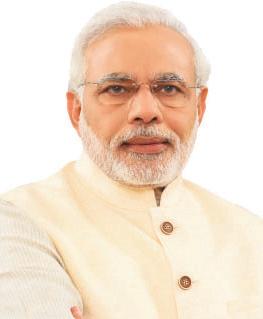
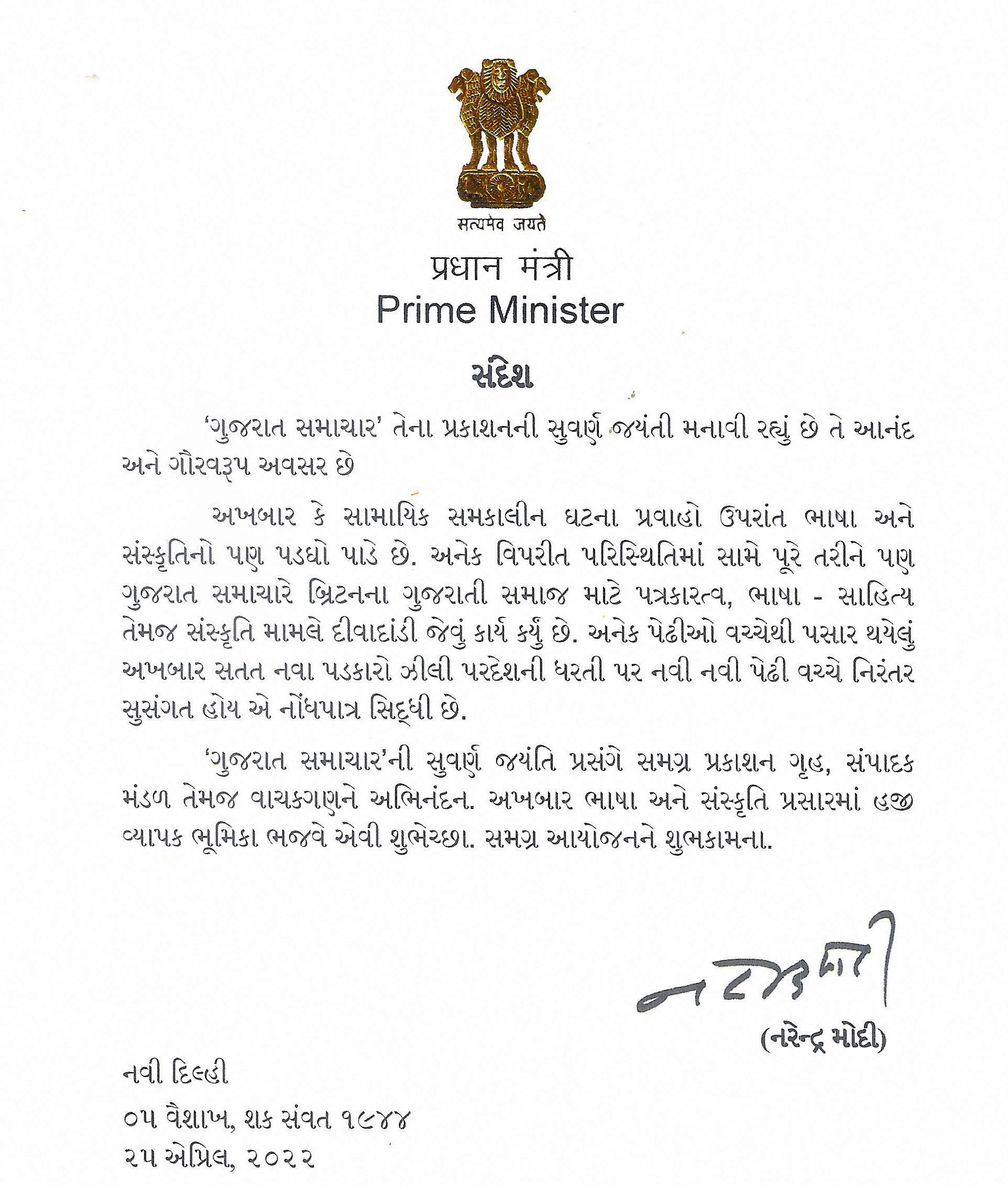

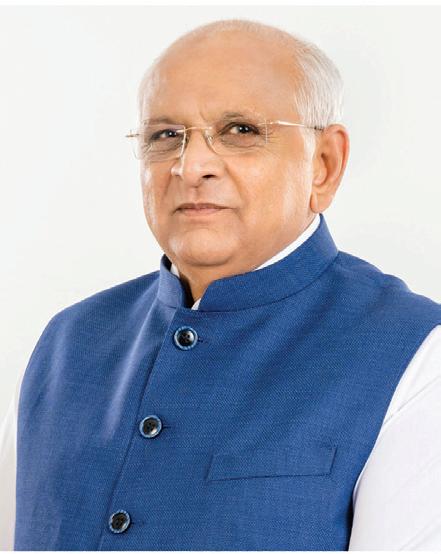


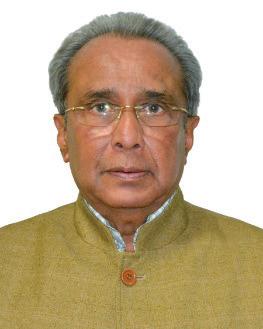
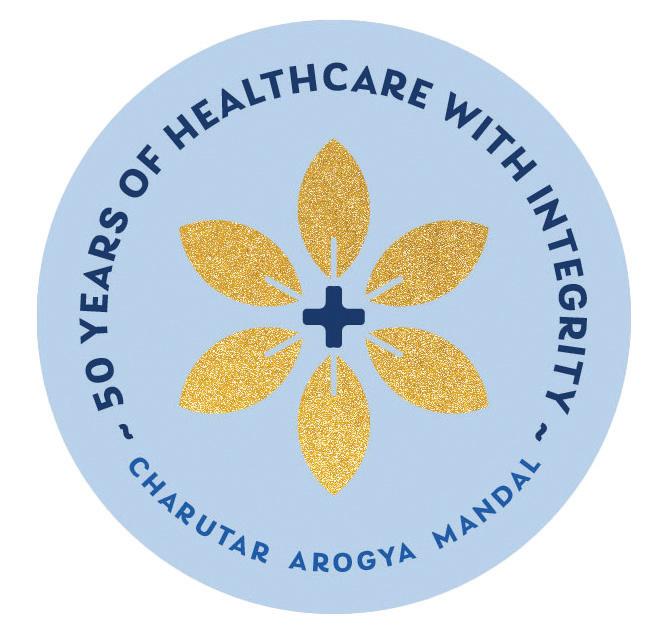


Asian Business Publications Ltd
Units

207-208 Harrow Business Centre
429-433 Pinner Road
Middlesex HA1 4HN
Respected Shri C B Patel, Namaste. Jay Swaminarayan. Aum Namah Shivaya.
From everyone at BAPS Swaminarayan Sanstha, we would like to convey our heartiest congratulations to Gujarat Samachar UK for over 50 years of shining service to society – a truly momentous milestone.
Gujarat Samachar UK has been a bridge linking Hindus living in the UK to our roots in India through your insightful news reporting and staunch support for Hindus as well as Hinduism in general.

Over the last 50 years, there has been tremendous change in our world, yet the one constant has been our Hindu faith and as we look to the future, harmony and mutual respect will underpin all that is achieved. That is why Pramukh Swami Maharaj inspired the building of mandirs, to promote peace and harmony across faiths and communities around the world.
We also wish you every success with the celebratory event that will be hosted at the British House of Lords.
Finally, we offer our prayers to Bhagwan Swaminarayan and Pramukh Swami Maharaj for the continued success of you and everyone at Gujarat Samachar and also for your personal good health. May you all continue to serve Gujarat, India, British Hindus and global Hinduism for many more decades to come.
With prayers and best wishes,
Sadhu Keshavjivandas (His Holiness Mahant Swami Maharaj)
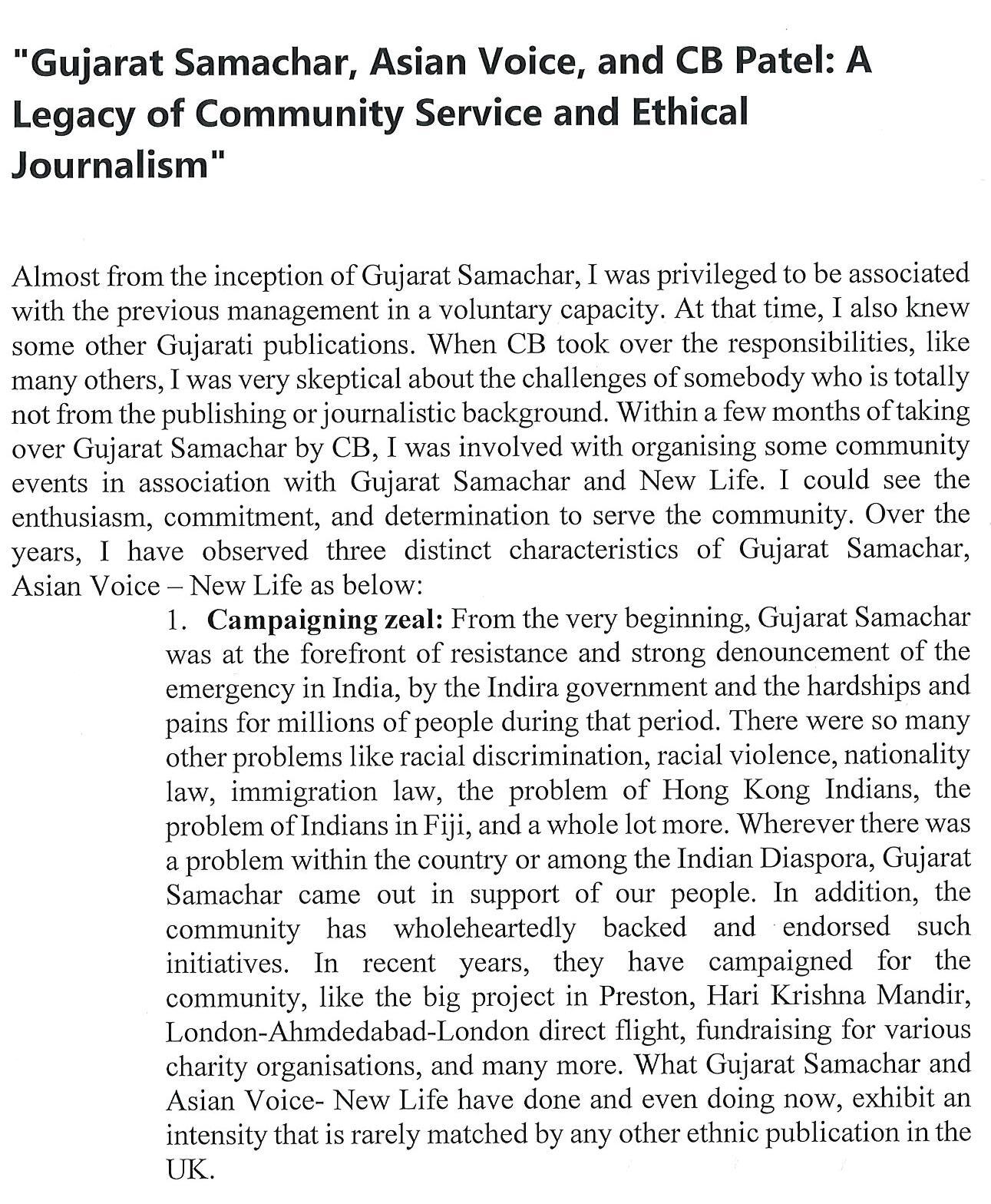





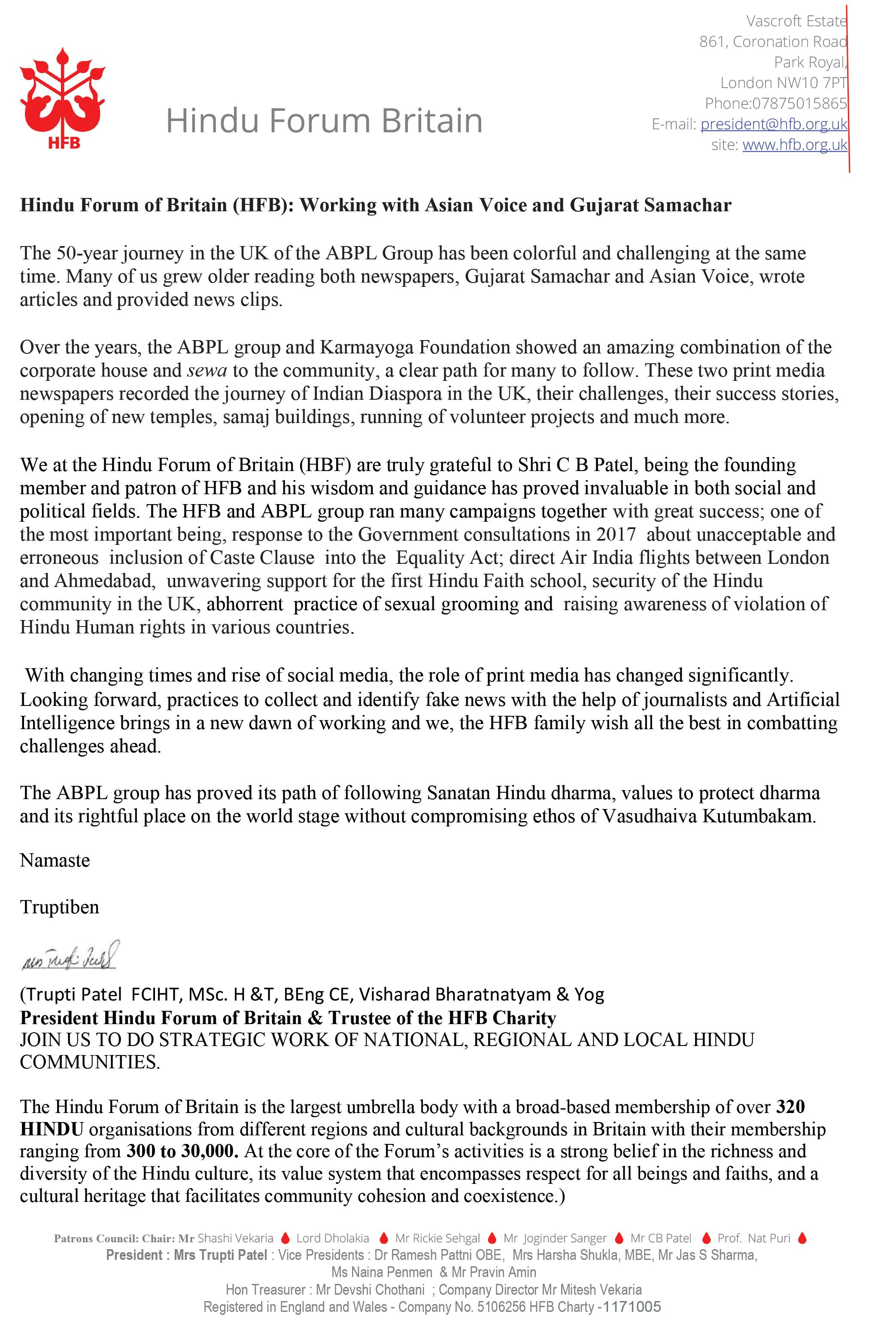


To all my readers, On the occasion of Golden Jubilee...Let’s walk through memory lane and hope for a bright future!

With the grace of the Almighty, and the support of my colleagues, readers, family members, friends and well-wishers, my world is full of blessings and happiness. I consider the principles of Karma Yoga to be supreme in my life.
When my friend Subhashbhai Thakrar, who is in-charge of our Golden Jubilee Magazine and celebration, invited me to write the foreword, it took me back to the past.

Subhashbhai, has been a friend and an advisor to me and my family, for more than thirty-five years. This commemorative magazine conceptulised by him, is a window to the future, while we fondly remember the remarkable journey of Gujarat Samachar till now.

For the last 51 years, I have put in my best efforts, as per my abilities and intelligence to perform my responsibility. At the same time, I acknowledge that in my journey, there are many contributors. On this auspicious occasion, I remember them and express my gratitude for their contributions. With the support and guidance of many benevolent individuals, I have been able to reach this success, far beyond the capacity and expectations of an ordinary boy from Bhadran, Gujarat. However, I cannot stop myself from specifically mentioning two particular individuals.
After living in this country for six years, my financial condition became better. I had the blessed opportunity to reunite with my father after 13 years, in 1973, who had already become a monk. We met at the sacred banks of the river Narmada and had a 20-minute conversation. During our discussion, he emphasised the importance of spreading wisdom and sharing knowledge. Though, I did not understand everything he said then, but it was quite enlightening. He mentioned that while achieving success and acquiring wealth are necessary in life, focusing solely on that is a mistake. Earn money, use it, support others in good work, and also enjoy life. But don’t waste money, try to invest more in worthwhile causes - that’s how my worldly ascetic father advised me.
His guidance may have seemed like an ever-evolving path and phases of ups and downs in life, but it paved the way for me. Five years later, in 1978, he went to Kailash.
My mother’s incident is nearly unknown to all of you. If I say, the years 1952-53-54 were extremely difficult and distressing for our family, then it would not be an exaggeration. I was scheduled to take my secondary school exams in 1954, but two years prior, I was completely occupied in taking care of my mother, who had contracted tuberculosis. So, I could barely study or prepare for my exams. I had to manage everything, from laundry to cooking to other household chores. It was indeed a blessed opportunity for me to serve my mother, and in doing so, I never hesitated.
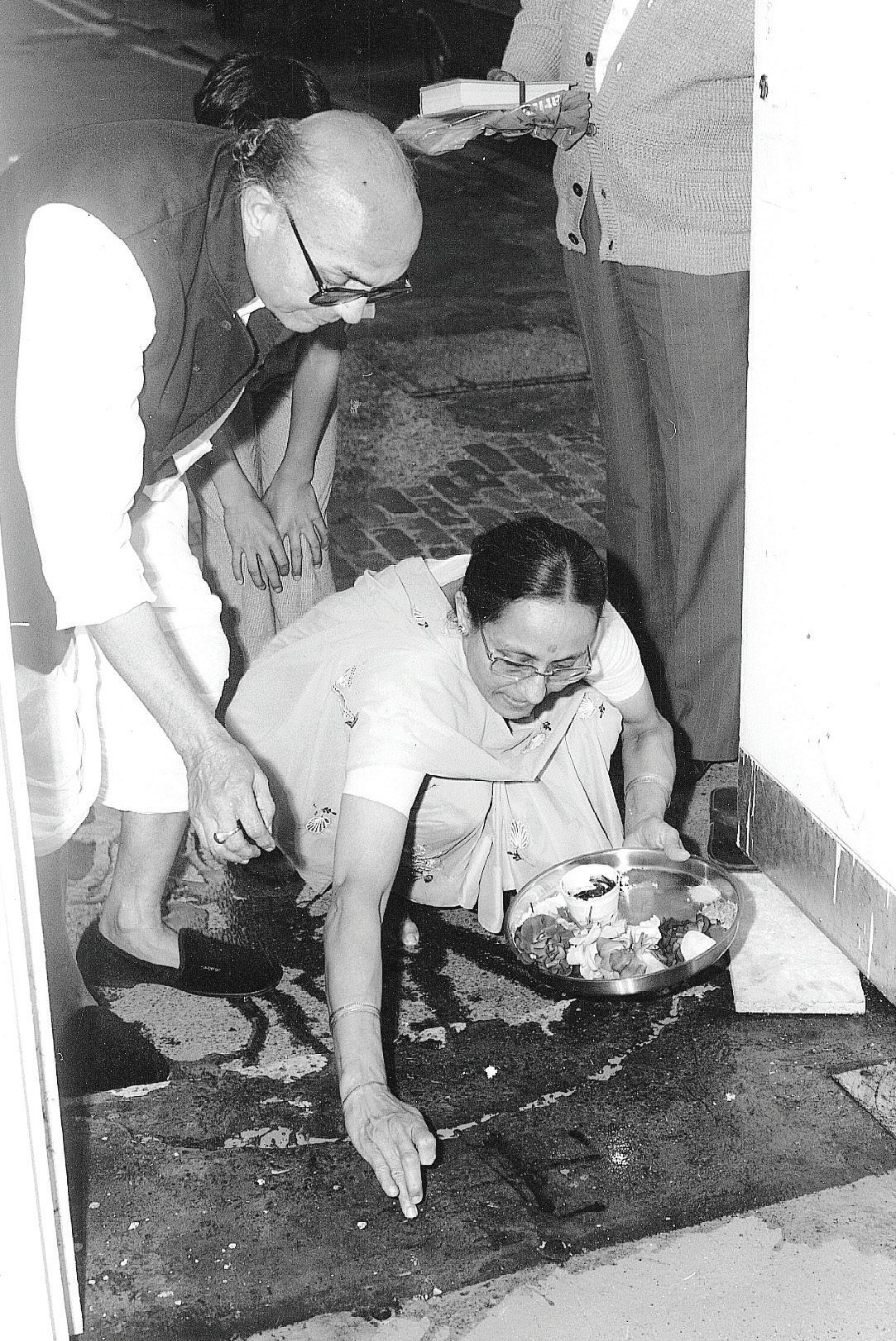 The Karmayoga house building was purchased in 1981. The mangal pravesh ceremony was conducted by Shri Chimanlal Fulashankar Shastriji. Shrimati Pushpaben Patel doing the auspicious sathiya and puja.
The Karmayoga house building was purchased in 1981. The mangal pravesh ceremony was conducted by Shri Chimanlal Fulashankar Shastriji. Shrimati Pushpaben Patel doing the auspicious sathiya and puja.
During this time, I got to know through my preliminary exams that I was weak in two subjects, and I was suggested to take private tuition. But the financial situation was so critical, that I couldn’t afford the fees. My mother called me over. She had saved a small piece of gold, which she put in my hand. She said, “Use it for your education.” It created a dilemma for me. I gave priority to my education. I studied more than just secondary school. Her sacrifice and faith have been the motivation in my life.
Over the years, our good days returned, and in 1983, Pujya Kamalaba came to London to bless us. She felt happiness to see me settled nicely. But along with that she was skeptical and worried too. One day she asked my younger brother Janardan while making him sit beside her, “Is your elder brother really well off?” Naturally, Janardan’s response was, “Don’t worry unnecessarily... everything is fine.” I believe that she might have felt relaxed after hearing that answer.
After some time, one day, my mother called me to our Ghar Mandir (home temple). I went and sat down beside her, while she engaged in a normal conversation about family matters. She enquired about acquaintances and general news.
During this conversation, I candidly expressed my desire and told her that whenever you plan to visit India, please let me know so that if you want to buy some gold jewelleries, we can do that, according to your wish.
She looked into my eyes filled with emotions and said, “You have the great grace of the Supreme Being upon you. Everything, be it wealth, mind, or body, is good for you. I don’t need to acquire anything. I have no interest in gold. Just a few simple things for you to keep in mind... continue doing good work, don’t let pride overpower you, and never forget that there is no greater deed than service of others, Gyan Yagna and Seva Yagna. “
Dear Readers, In the context of these life events, I can say without hesitation that whatever has happened in my life is due to the grace of God and the blessings of my parents. On a personal level, I am firm about not receiving excessive praise for me.
Materialistic well-being is important but intellectual and spiritual growth holds special importance. It’s our responsibility to take care of our inner peace and mental well-being for fulfilling life.
I express my deepest gratitude to those individuals who have contributed to the work of my publications. When this journey started, this endeavor seemed challenging, but with the grace of the divine being and the support of you all, life and work have been simple and effortless.
May your blessings and best wishes be always there with me and our ABPL Group.
Yours
 C B Patel
Om Namah Shivay
C B Patel
Om Namah Shivay
(Originally Written in Gujarati: Pg.124)
As ABPL Group completes 50 years under the legendary leadership of Mr CB Patel, it is worth recognising the commendable service the two newspapers - Gujarat Samachar and Asian Voicehave done to the community. The weekly publications have become part of the Asians, particularly the Gujarati community. The publications not only serve the society with news but also get involved in many seva projects.

There is an article of the history and milestones in this book highlighting important achievements of the group. It is commendable that at age of 86 CB remains quite energetic and full of inspiration to achieve yet more.
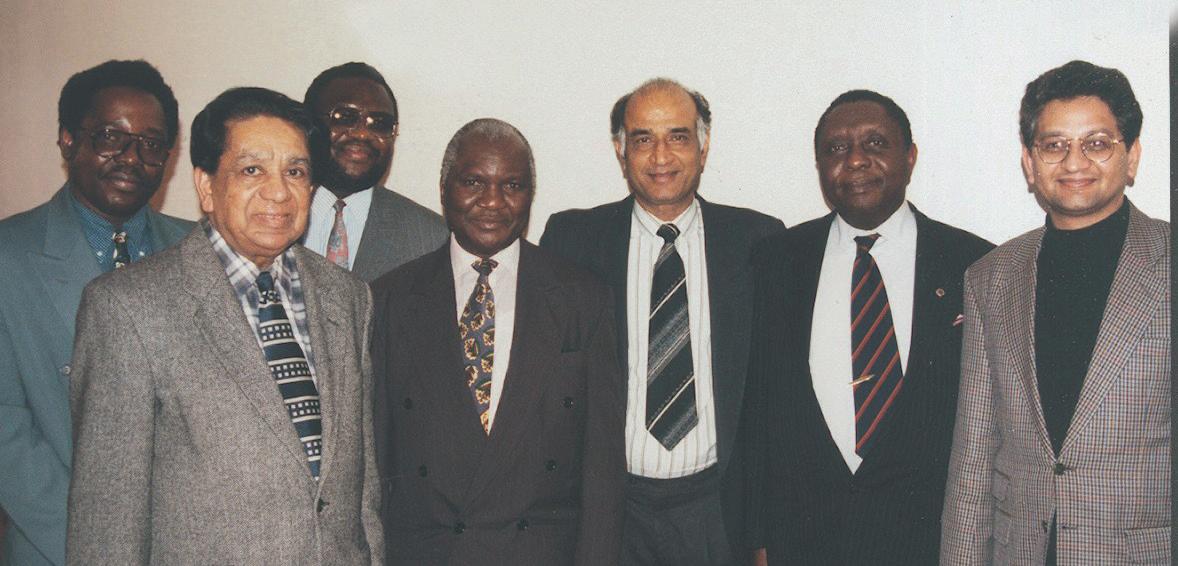
In my discussions with CB for the desire to leave a lasting mark of the 50 years of service, we came up with the idea of this unique book where, on the one hand we are recording Asian Voice and Gujarat Samachar’s history and on the other, we have an array of fantastic articles from prominent authors whom we asked to imagine how their specific sectors of interest would look in 25-30 years from now. This book is futuristic and, by definition, will take the reader to think forward and imagine with the author. This is the contrast and uniqueness of this book- Eyes for Tomorrow.
This hard bound book will have a long shelf life as it is futuristic in its nature. In the same way, Asian Voice and Gujarat Samachar must also look into the future and develop a strategy for longevity and a legacy for our society.
If we just look back at the last 25 years and compare it with today, we can see that our lives have changed drastically. Just look at the advent of mobile phones - in the past we only had landlines and international calls were prohibitively expensive. Forwarding messages or
 In 1990, African representative group at CB’s residence. Pranlal Sheth (left) and Subhashbhai Thakrar
In 1990, African representative group at CB’s residence. Pranlal Sheth (left) and Subhashbhai Thakrar
photographs to anyone meant using what we now call ‘snail mail’ which took days. Now our smart mobile phones are minicomputers that enable instant connectivity worldwide; flow of messages and photos or videos are also instant. We can easily make video calls and converse, have social and business interactions. Phones are now instant movie machines, diaries, health monitors and much more. If so much has changed in just 25 years, can we imagine the method of communication in the next 25 years? It is possible we may not need to have the phone unit. May be, it will be in a chip inside our bodies! Well, I leave that to the experts.
The progress with cars in the last 25 years has also been noteworthy. Today modern cars are electric, have 360 degrees cameras that enable cars to be driven on their own in full safety. The cameras can see more than our eyes! Gone are the days when we had to peel our eyes over an atlas to find direction. Now the navigation systems have changed everything. Very soon cars will be driver less. Today, we are talking about the topics of our generation. They are Artificial Intelligence and Climate Change. Both will have significant influence on our lives in the next 25 years and beyond. We shall see many things that we use and enjoy now, getting replaced by new and more advanced things and we shall quickly forget the past and adopt new technologies as if they have always been part of our lives. Human beings are very imaginative and new solutions to current challenges will be invented. I have no doubt that our future will be bright.
One thing noticeable is that the pace of change continues to increase over time. The changes in the last 25 years are far more than 25 years before. Similarly, next 25 years will see the pace of change much faster than what we have witnessed in the last generation.
I hope you will enjoy reading the various original articles from a fascinating array of specialist authors. Let this book be a reference book for you to compare and monitor as years pass or may be the next generation will read the book and amuse themselves on the thought

process of the last generation! This itself will mean the book will have a long shelf life which I wish personally. And the new style Asian Voice and Gujarat Samachar will live in parallel helping and serving our society.
I am immensely grateful to all the contributors to this book. The various authors of the articles have done justice to make this book have a title of Eyes for Tomorrow. Krisha Mutta helped in choosing the beautiful title and the design of the book with such vibrant colours drawing our attention to the future through sunrise.
We have also had fantastic support of our Patrons, who were willingly come forward and provide fantastic support. We restricted participation to no more than 20 Patrons. They are specially mentioned in the book and will forever be part of the foundation stone of a new Asian Voice and Gujarat Samachar as the publications enter a new gear and new direction for another 50 years.
With affection

Subhash V Thakrar
(Subhash Thakrar is former chairman of the London Chamber of Commerce, former Commissioner of the UK Department of international Development, Fellow of Royal Society of Arts and Chair and board member of a number of charities and companies.)

In 1996 inspite of going through a major knee-surgery Kamlaben- CB’s mother joined the charity walk performed for the well being of senior citizens in Gunnersbury Park, Acton. She walked with the help of crutches and was joined by her family members.

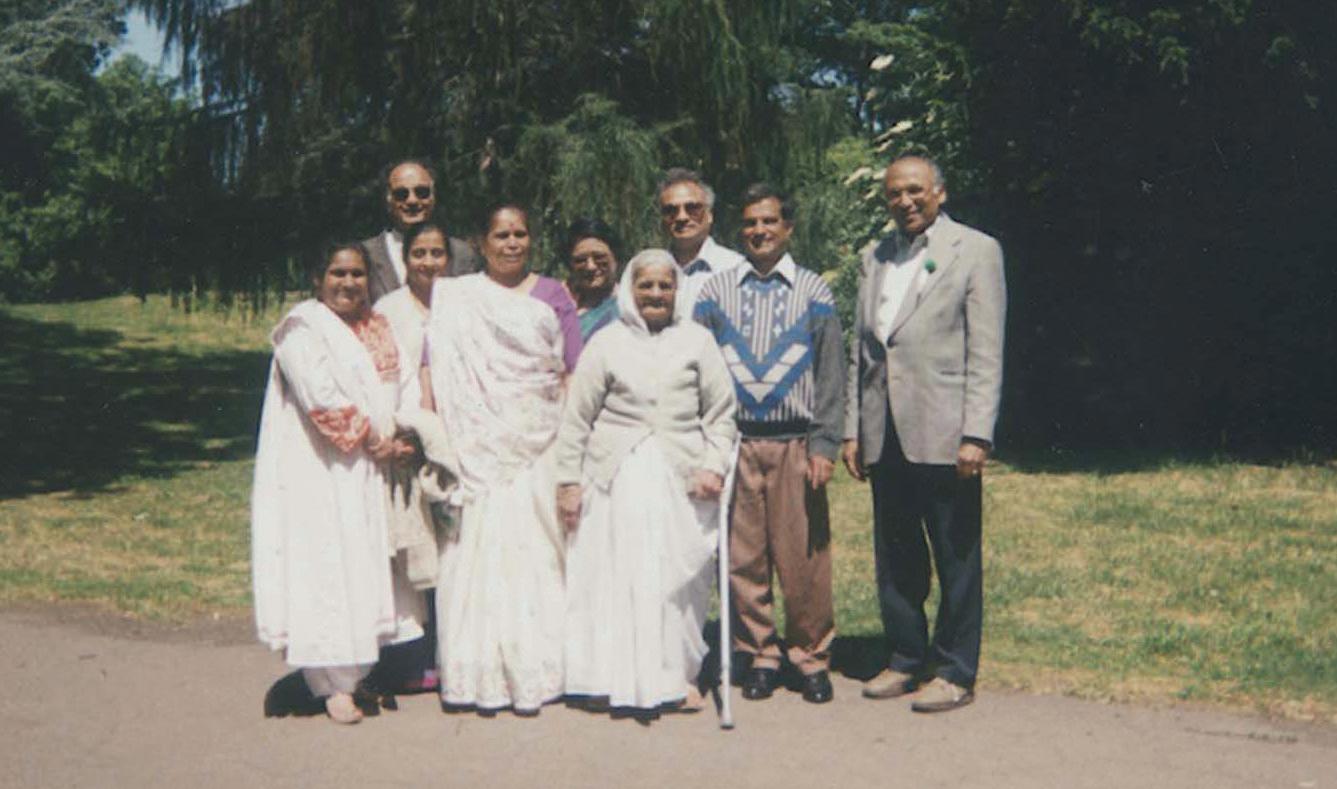
In 1980 hand composing was replaced by electronic machine Linotern on which Gujarati font typesetting was done. Shakuntalaben with CB.

Sports are becoming increasingly competitive and athletes aiming to be the world’s best require tailored mental and physical regimes. For instance, be it tennis or cricket, gone are days of say, a John McEnroe in tennis or a Faroukh Engineer in cricket as compared to fitness levels of a Novak Djokovich or a Virat Kohli. In an effort to build better athletes, four leading University of Birmingham academics from the School of Sport, Exercise and Rehabilitation Sciences have conducted several research studies. Their findings include:
Nutrition
Dr Gareth Wallis (BSc Sport and Exercise Sciences, 2000; PhD Sport and Exercise Sciences, 2006) returned to Birmingham to research nutrition. He says: “I think the future
is in personalisation and the use of technology, integrating physiological monitoring with nutritional guidance to offer individualised information. We are not there yet, but it’s a potential direction for elite athletes. “We recently examined whether carbohydrates help the body recover from exercise. If you eat fructose (the sugar found in fruit) with glucose-based carbohydrates, studies suggest this can extend how long you can exercise. Athletes should consider ingesting at least 1.2 g carbohydrate per kilogram body mass per hour - for the first few hours of recovery - as a mixture of fructose and glucose-based carbohydrates. However, if your goal is burning fat, athletes could consider restricting carbohydrate intakes during recovery from some key training sessions.
(Courtesy: University of Birmingham)
“We have also researched whether you should eat before exercise. There is evidence that exercising without eating breakfast can enhance the skeletal muscle metabolic profile for young, healthy men. However, we need to examine long-term studies to understand whether this is true for everyone. Further long-term studies are required, particularly in people who are at risk of or living with cardio-metabolic disease.”
Dr Jamie Pringle has provided physiological support to several Olympic medal-winning athletes and record-breaking cyclists. He says: “These days, data is just as important as the equipment an athlete might use. For example, in the lead-up to the Beijing Olympics, a performance analyst for GB Boxing put together a matrix of information on opposing boxers – who they had fought, who had won, what punches were effective – and from that you could establish the probability of whether particular tactics will work or not. That kind of information helped Sir Mo Farah’s tactics: at his peak, if he was within two metres of the race leader, and Mo ran a 52-second final lap, he would invariably win. No-one could match his sprint finish.
“With access to more information than ever, the smart use of data is where I think you will see further
progress in the future. Innovation is fundamentally doing the same things differently to try to make them better or doing different things to try to find the same answer. With the wealth of data now available, better analysis of that data will be key.”
The surrounding environment is essential for any athlete. Professor Joan Duda was the sport psychology consultant for the Women’s US Olympic team that won the gold medal in the Atlanta 1996 Games. She says: “Our research has proved that empowering environments increase motivation and positive engagement in sport. The results show that good coaches focus on mastery and personal improvement, provide ‘voice and choice’ to participants, and are caring and respectful. In contrast, when coaches are controlling or intimidating and emphasise being better than others rather than doing one’s best, they are disempowering. We have developed these into our Empowering Coaching practices, which have recently been adopted across 13 different countries.
“Self-regulation skills are also key. This helps athletes spot when they are thinking optimally, when they are not and how to return to that optimal state.”
General fitness is a broader issue which needs equal attention. Dr Liam Anderson is using his years of experience at football (soccer) clubs to bridge the gaps between science and performance. He says: “COVID-19 caused mass disruption to professional soccer and meant we needed to research an alternative approach to training. Professional soccer players typically focus on training and match play, rather than general fitness.
“During lockdown, we researched the effectiveness of a 13-week remote physical training programme. Professional players measured their fitness before and after using the training programme at home. The results they sent us suggest that alternative modes of training can be used where team-based, soccer specific training is not available, without negatively impacting physical development.”
(Courtesy: University of Birmingham)
Diabetes has become the scourge of society. It needs constant research and study to improve on existing treatments. In the UK, Birmingham has the highest rate of diabetes; nearly one in 10 people in some parts of the city. This has prompted the University of Birmingham to launch five new major studies, many funded by charitable grants, aimed at improving the prevention, treatment and management of type 1 diabetes – with a particular focus on children and young adults.
Unfortunately, treatment for type 1 diabetes, in which the immune system attacks the cells that make insulin, has not changed much since insulin was first discovered 100 years ago. In the UK, diagnosis still relies on waiting patients to come in, often with quite acute symptoms. While diet and physical activity can help
reduce the risk and manage type 2 diabetes, in which the body does not make enough insulin or the body does not respond to it, the causes of type 1 are still mysterious.
Professor Parth Narendran, who leads the EarLy Surveillance for Autoimmune diabetes (ELSA) study at University of Birmingham, says: “Studies have recently shown that some medicines can safely delay people getting type 1 diabetes. Some countries, such as the US and Australia, already have surveillance systems to identify people at risk of developing type 1 diabetes and to offer them participation in prevention trials and to reduce their chances of developing it, as an unexpected emergency.”
Dr Faye Riley, Research Communications Manager at(Courtesy: University of Birmingham)
Diabetes UK which is funding the ELSA study says: “We’re proud to support pioneering research at the University of Birmingham that has the potential to transform how type 1 diabetes is identified and managed in the UK and help prevent its serious complications.” Diabetes UK is also supporting Dr José M Romero’s research into preventing vision loss. According to Dr Romero: “Around 80% of individuals with type 1 diabetes develop some type of eye complication within 20 years. Our research could help identify ways to treat or prevent vision loss.”
Dr Railey adds: “The symptoms of type 1 diabetes – the 4Ts – feeling more tired or thirsty than usual, going to the toilet more often and unexplained weight loss (becoming thinner), can come on very quickly and often require hospital treatment, where many people are diagnosed. Parth’s research could pave the way for a future where we, no longer have to wait until type 1 diabetes develops to treat it, giving everyone a better chance of a safe diagnosis, and access to exciting new treatments that could delay or prevent the condition.
“As we work towards curing and preventing diabetes, we also need to stop the harm it causes. Diabetes is the leading cause of preventable sight loss in the UK, but research like Jose’s could help to change that.”
The research is vital as it will provide answers to five critical situations type 1 diabetes patients are faced with:
Should we screen children for early signs of type 1 diabetes?
Led by Prof Narendran, researchers in the ELSA study will test 20,000 children for early type 1 diabetes and interview families, doctors, nurses and schools, to determine if and how the UK should test and monitor children to identify those at risk of type 1 diabetes. Apart from Diabetes UK, the ELSA study is also being funded by Juvenile Diabetes Research Foundation (JDRF) and National Institute for Health Research (NIHR).
Two projects led by Dr José M Romero will explore how new therapies aimed at protecting mitochondrial function can be exploited to prevent multiple health conditions (funded by the European Foundation for the Study of Diabetes) and prevent people developing an eye condition that can cause sight loss and blindness (funded by Diabetes UK).
Recent clinical trials demonstrate that type 1 diabetes can be
significantly delayed with a short course of immunotherapy, revolutionising thinking around prevention and ‘cure’. A clinical study led by Professor David Wraith, funded by the Leona M and Harry B Helmsley Charitable Trust, will test a new peptide developed at Birmingham, which has the potential to control the T-cell immune response.
Led by Dr Alex Wadley and funded by the Rosetrees Trust, this research will examine how a home-based exercise programme impacts autoimmunity in newly diagnosed patients. The project will evaluate whether exercise slows the progression of type 1 diabetes by altering the number and activity of white blood cells that could damage the pancreas.
How does poverty and/or ethnicity affect how people manage diabetes?
Professor Tim Barrett’s team will ask how income, food availability, language issues and living conditions affect how children and families manage type 1 diabetes, to identify new ways to make diabetes management easier and more successful, then test them in trials
involving NHS hospitals. Funded by NIHR.
Over the past century, chemistry has made incredible progress thanks to technological innovations. These innovations have helped tackle various global challenges, such as improving food production, treating diseases, and developing materials for transportation, batteries, and clothing. However, there is still much work to be done to improve these technologies by making them more affordable and environmentally friendly. To achieve this, scientists are now using artificial intelligence (AI) to revolutionise scientific discovery.
AI is currently being used in a specialised manner, where each AI model is trained for a specific task. An example of this is how we use AI to identify spam emails. The AI algorithm is given a dataset of emails marked as “spam” or “not spam,” and it learns to distinguish between the two types. Similarly, in chemistry, AI helps classify molecules (used in medicines, food colorings, perfumes, etc.) as “toxic” or “non-toxic” to ensure safe usage. This specialised
Dr Amol Thakkar is a research scientist with a background in artificial intelligence applied to chemistry. He has worked across the technology and pharmaceutical sectors, delivering AI solutions for digitizing laboratories.

Another application of AI is in language processing, which has led to advancements in translation services. By training models with datasets containing words or sentences in different languages, the AI learns to translate between those languages. The models are like children learning languages and improve by repeatedly getting feedback until they provide correct answers. Large language models like ChatGPT have been developed using vast datasets containing text from various sources and multiple languages.
Now, imagine applying this AI technology to the field of chemistry, where molecules are treated as a language. This opens up exciting possibilities for scientific research. We can use language models to design new medical drugs, predict how to create them, and even communicate with laboratory robots to assist in molecule creation.
AI language models have also been used to solve complex biological problems, such as predicting protein structures, which traditionally took years of laboratory work.
To ensure the accuracy of these AI models, we must use highquality data. As AI becomes more integral to scientific discovery, data infrastructure innovations will play a crucial role in developing and
applying these models effectively. Collecting relevant data for specific problems remains challenging, but efforts are being made to address this issue.
In the future, data collection will continue to grow, and we will need better infrastructure to manage and access the vast amount of data. Specialised AI models will also play a significant role in solving specific problems. The power of these specialised models can be enhanced through new technologies that coordinate how different models work together based on the context. This will lead to more intelligent systems acting as digital assistants, driving innovation to address some of the world’s toughest challenges.

Innovation in life sciences can help economies to grow, create jobs, and save lives. It means a company launched in a garage can go on to export to 120 countries. The very same company can deliver medicines twice daily to every hospital and pharmacy in the UK. Additionally, it can transfer its ethos of innovation and turn it into a charitable foundation which will save one million lives.
We did it. The company is Morningside Pharmaceuticals, which my wife and I founded back in 1991.
It now works with aid organisations including UNICEF, Red Cross, and Médecins Sans Frontières on making quality healthcare accessible and affordable around the world. During the pandemic, we saw, once again, how innovation in UK life sciences saves lives. It encourages that restless desire to do more which is fundamental to a forward-looking United Kingdom.
Dr (Prof) Nik Kotecha OBE DL is the founder of Morningside Pharmaceuticals. He is the founder and chair of the which is working towards saving one million lives in the UK and around the world.
- and ultimate resettlement in Leicester - has had a lasting impact on my life.Morningside was made possible through early investment in the shape of a local council grant which enabled me to pursue higher education. That led to a PhD at Imperial College, London, then doctorate work at Cambridge University. Opportunity led to inspiration as I researched drug discovery, and it became clear to me why there was a lack of competitively priced high-quality medicines in the developing world. Inspiration led to innovation as I founded a garage start-up to do something about it.
The government intends to use the agility afforded by Brexit to inform choices which will move the UK towards a high-wage, high-skill economy. Life sciences is consistently presented as one of Britain’s key growth sectors. It employs about 282,000 people and generated £94 billion in 2021.
The Chancellor has identified the sector as an asset larger than in any other country, bar the US and China. In a speech at Bloomberg, he noted the opportunity of R&D in life sciences as having the potential to add an additional £68 billion in GDP over the next 30 years.
The sector does indeed represent a significant opportunity for growth, as global demand for medicine shifts from cost towards supply chain resilience. While this will not result in the wholesale return of industries previously moved offshore, it will, however, see international relationships become ever more important as demand increases in domestic markets.
The global scramble for PPE in the early stages of the Pandemic demonstrates this need for strategic thinking. But success will also require a complete rethink of domestic skills and training as we secure our supply lines.
As with the PPE supply in 2020, UK charities also find themselves at the mercy of global forces. Many are faced with increased uncertainty due to factors such as reduced grant funding. In such an environment social enterprise is becoming a way of generating income and building resilience.
One such example is in Leicestershire, where a charity for people in crisis has taken control of its supply chain by directly sourcing white goods which can then be funded by small grants from larger charitable foundations.
On the other hand, innovation brings with it the inevitable risk of failure, which naturally makes many charities uncomfortable. Social enterprise is, after all, often predicated on donations.
Ambitious charitable projects can gain inspiration from how businesses raise investment for innovation, discovery, and to deliver mission.
The US model of philanthropy uses strategic tools such as pledges from multiple foundations, matchfunding, and bank bonds to meet need and create positive change. For instance if a charitable project needs to raise £1 million, the traditional UK response would often be an inefficient raise-spend-raise cycle.
The US philanthropy model is different. Imagine that five foundations were identified, each prepared to commit £200,000. This would be dependent upon the project being delivered with a promised impact and outcomes. A bank thereby issues a bond - potentially as part of its own CSR agenda - enabling smaller investors to simultaneously gain a modest financial return from doing good.
Collaboration can dramatically increase financial impact - and with mutual benefit. The same is true when philanthropy overlaps with policy. The Randal Charitable Foundation, for example, was one of several to come together to raise support for an evidence-based project led by the Centre For Social Justice.
The initiative helped shape policy which unlocked an extra £80 million for drug treatment services as part of the government’s efforts to cut crime which would also save countless lives. My vision for the coming decades is for UK philanthropy that is outward-looking, but also highly impactful, innovative, and scalable. The sector can do that by learning from various business models. It can do it by moving outside of established and existing approaches. It can do it by innovating.
The last six months has seen an explosion in discussions about Artificial Intelligence (AI) and its likely consequences. AI has emerged as a transformative force, with the potential to revolutionise multiple sectors – both public and private - and propel the United Kingdom into a new era of technological advancement. The significance of AI cannot be understated; it is, without a doubt, the most influential ‘enabling’ technology of our time. Generative AI systems like GPT-4, are disrupting knowledge production, problem-solving, and accessibility globally, underscoring the need for
proactive management of the risks and opportunities.
Healthcare is one of the sectors that can benefit most from advancements in AI with the promise to revolutionise medical processes and services. For example, AI-powered diagnostics can aid in the early detection of diseases and improve accuracy, enabling more effective treatments and ultimately saving lives.
Lord Jitesh Gadhia is an investment banker and businessman and has been a Member of the House of Lords since September 2016. He was previously Senior Managing Director at Blackstone based in London and has over 25 years’ financial services experience, having also held senior positions at Barclays Capital, ABN AMRO and Baring Brothers.

AI algorithms can analyse medical images with remarkable precision, assisting healthcare professionals in identifying abnormalities that might otherwise go unnoticed and AI-driven pathology streamlines the analysis of tissue samples, expediting diagnosis and providing crucial insights into disease progression.
Moreover, AI’s role in personalised medicine is changing the healthcare landscape. By leveraging AI to analyse vast datasets of patient information, healthcare providers can develop tailored treatment plans based on an individual’s genetic makeup, lifestyle, and medical history. This personalised approach enhances treatment efficacy and reduces the risk of adverse reactions to medication.
Additionally, AI can accelerate drug discovery and development, significantly shortening the time it takes to bring new drugs to the market. The use of AI can help identify promising drug candidates much faster than traditional methods by simulating and predicting the interactions between potential drugs and biological systems. This efficiency in drug discovery expedites medical breakthroughs and reduces the overall cost of drug development, making essential treatments more accessible to the public.
AI has also shown immense potential in various other sectors, such as finance, transportation, and education. AI-driven algorithms optimise financial systems, enabling better risk management and fraud detection. Self-driving vehicles powered by AI have the scope to revolutionise transportation, making it safer and more efficient. AI-based educational platforms personalise learning experiences, catering to individual students’ needs and enhancing educational outcomes.
However, alongside the unprecedented opportunities, AI also brings significant challenges. Concerns about data privacy, bias in algorithms, the dissemination of misinformation, and security threats demand vigilant attention. The rapid advancements in AI have outpaced existing regulatory frameworks, necessitating agile and adaptive governance to mitigate potential risks effectively and avoid unintended consequences.
Proper governance of AI is the key to maximising its potential while safeguarding societal well-being. A robust regulatory framework is essential to ensure AI’s responsible and ethical use. Collaboration on an international scale is equally critical, as addressing global AI challenges requires shared knowledge and collective action. The UK can play
a pivotal role in fostering this international cooperation, serving as an enabler and alliance builder in the AI revolution. So, it is welcome that Prime Minister Rishi Sunak is convening a Global Summit on AI Safety in Autumn 2023.
One recurring concern is the potential impact of AI on the employment market. While AI has the potential to enhance productivity and efficiency, there are legitimate fears about job displacement and inequalities in wealth distribution. Ensuring our workforce has the necessary skills for the AI-driven economy of the future is imperative.
AI’s influence on information integrity and journalism is also of paramount importance. The rise of AI-generated content has raised questions about authenticity and reliability. Addressing deepfakes and synthetic media requires robust regulations that safeguard against the misuse of AI-generated content and ensure adherence to ethical standards.
As AI continues to reshape various sectors, strategic governance is vital. The UK can lead in safe and reliable AI development and regulation by investing in research and development, fostering collaboration, and establishing a robust regulatory environment. By doing so, we
can ensure that AI’s benefits are harnessed responsibly and ethically, whilst effectively managing its potential risks. Public engagement is also crucial in building trust and ensuring that AI deployment aligns with societal values and preferences.
The coming years will be crucial in determining the future of AI, and the UK must seize this historic opportunity to drive progress, innovation, and societal well-being through a well-crafted regulatory environment for AI. No country or company can shape the future of AI alone. Only with the combined focus, ingenuity, and cooperation of the international community will we be able to, fully and safely, harness the potential of AI. By taking such a proactive and multilateral approach we can simultaneously manage the risks and unlock the full potential of a transformative technology which will undoubtedly shape all our futures in the next 25 years.
Advances in biomedicine have vastly improved healthcare over the world, including its poorest countries. And they have extended lifespans; over the past 25 years an average human has gained seven years of life expectancy. The gain is more than just staying alive: the number of healthy years we can expect to enjoy has risen too. In the Covid 19 pandemic, science has been our salvation – vaccines were developed with unprecedented speed (Remember that after 40 years still don’t have an effective one against HIV).
Future
benefits to humanity could be greater still. At the same time, this progress creates vulnerabilities and ethical dilemmas. Most obviously, the benefits are still unevenly shared, both within countries and, even more so, between richer and poorer nations. Reducing these inequalities is surely an imperative. Sadly, the trend is now in the wrong direction: there’s too much focus on ‘diseases of the rich’ rather than on infectious diseases.
Throughout the history of medicine, people have recoiled at innovations that seemed to go against nature, including
Martin Rees (Lord Rees of Ludlow, OM FRS) is an astrophysicist and cosmologist, and the UK's Astronomer Royal. He is based at Cambridge University where he has been Professor of Astronomy and Director of the Institute of Astronomy. He is a Fellow (and Former Master) of Trinity College.

vaccination, transfusions, artificial insemination, organ transplants and in-vitro fertilization. The fact that these are unexceptionable today is a reminder that squeamishness at the new is not a reliable guide to what becomes deemed ethically defensible. More recent techniques that are still controversial include stem cell research and mitochondrial transplants (so-called three-parent babies). The gulf between what medical science may enable us to do, and what is prudent or ethical to actually do, will shift, widen and, in many cases, be difficult to cope with.
The cost of sequencing DNA has plummeted dramatically. The decoding of the first human genome, completed in 2003, was quintessential Big Science – an international project with a $3bn budget. But the cost of human genome sequencing has fallen to below $1,000, and soon it will be routine for all of us to get sequenced. At the same time, it has become feasible to synthesize genes and even simple genomes from scratch.
However, most people distinguish between an intervention that would remove something harmful, which they welcome, and one that would enhance what we already have, which they fear. Whether or not this difference is morally significant (or even, in many cases, meaningful), the actual prospect of genetic
enhancement of humans is, perhaps fortunately, remote. A few genetic diseases, including Huntington’s, are caused by a single gene that could be snipped out by the CRISPRCas9 gene-editing technique. But most, such as schizophrenia or a susceptibility to Alzheimer’s or cancer, are the product of hundreds or thousands of genes, each tweaking the probability of a person having the disease by a tiny amount. This may be even truer of traits and talents such as height, intelligence and personality.
Only when the DNA and trait profiles of many millions of people are available will it become possible (using pattern-recognition systems aided by AI) to identify desirable combinations of genes. Not until this can be done – and genes can be confidently synthesized without inducing new ‘downsides’ -- will “designer babies” become conceivable (in both senses).
But there are genuine concerns about where advancing genetics could take us. (Indeed, there is widespread reluctance to properly discuss the issue, because it seems redolent of the now anathematized eugenic movements in the first half of the 20th century.)
Research on ageing exemplifies such concerns: there is an obvious
incentive to pursue research with the aim of prolonging our healthy lifespan. ‘Altos’ laboratories aiming to address these problems have been set up in California (in the San Francisco Bay area and in San Diego) and in Cambridge (UK), funded by some US billionaires – people who, when young, aspired to be rich; and having achieved riches, want to be young again -- that’s not so easy! Will the benefits be modest and incremental? Or is ageing a ‘disease’ that can be held at bay or even eliminated? Dramatic lifeextension, if it proved possible at all, would initially be the privilege of a wealthy elite – a fundamental new kind of inequality. But if it became widespread, it would plainly be a real ‘wild card’ in population projections, with huge social ramifications (multi-generational families? A later menopause? etc.).
In addition to the distinction between curing and enhancing, many people draw a line between genetic manipulations whose effects are restricted to individuals’ own bodily tissues and those that reach into the eggs or sperm and are passed down to their progeny. Indeed, manipulation of the germ line of other species forces us to think hard about our ethical intuitions. There has, for instance, been an attempt in parts of Brazil and other areas to sterilize and thereby reduce – and even wipe out –
the species of mosquito that spreads the Zika and dengue viruses; the trials recorded a 90 per cent reduction in local populations of the species. Is it bad to ‘play God’ in this way? Similar techniques are being proposed that could preserve the unique ecology of the Galapagos Islands by eliminating invasive species such as black rats.
If the relevant technologies continue to advance, there seems a real longterm prospect that human beings – their brains and their bodies –could be ‘enhanced’ via genetic and cyborg modification. Moreover, this future evolution – a kind of secular ‘intelligent design’ leading even to a new species – might take only centuries – in contrast to the thousands of centuries needed for Darwinian evolution.
This speeded-upevolution, incidentally, would be a game changer. When we admire the literature and artefacts that have survived from antiquity, we feel an affinity, across a time gulf of thousands of years, with those ancient artists and their civilizations. But we can have zero confidence that the dominant intelligences a few centuries hence will have any emotional resonance with us—even though they may have an algorithmic understanding of how we behaved.
Genetic manipulations are by no
means the only ethical challenges that will sharpen up as biomedical science advances. We will also face acute dilemmas about treating those at the beginning and those at the end of their lives. Everyone treasures the prospect of living out more healthy years, while most people dread the prospect of being kept alive in pain or with severe disability or dementia. ‘Assisted dying’ or ‘voluntary euthanasia’ is now legalised, with safeguards, in several European countries, and several US states. In the UK public opinion is 80 percent in favour of legalisation. Professional medical opinion is shifting towards acceptance, and now seems evenly balanced; one can even find archbishops on both sides of the argument. Likewise, the ability to treat premature babies can be miraculous, but it might also mean saving children who will never flourish, laying out an ethical minefield. These are instances where there’s a blurred boundary between issues where scientists deserve special attention as ‘experts’, and those that are ethical rather than technical, where they speak, along with the rest of us, only as citizens.
Research on viruses, such as the arch-villain of Covid-19, raises dilemmas that are both incendiary and timely. In 2011 researchers at the Erasmus University in the Netherlands and at the University of
Wisconsin in the US showed it was surprisingly easy to make the H5N1 influenza virus both more virulent and more transmissible – defying the evolutionary dynamic that ordinarily trades one of these features against the other (since a virus that kills its host can no longer use that host to spread itself). These Faustian “gainof-function” experiments were justified as a way to stay one step ahead of natural mutations, but they could be used with evil intent. The US federal government banned these experiments in 2014, but for reasons that seemed somewhat unclear, relaxed the rules three years later.
Although a non-expert, I first wrote about these bio-hazards in 2003; and some better-informed colleagues thought a catastrophe was even more likely to happen than I did. On the Long Bets website maintained by the ‘Long Now’ Foundation I wagered that “Bioterror or bioerror will lead to one million casualties in a single event within a six-month period starting no later than 31 December 2020”. For humanity’s sake, I of course fervently hoped to lose this bet, and I was not surprised when, in 2017, psychologist Steven Pinker took me up on it, with a $400 stake (the winnings going to charity). Steven had written two books documenting historical declines in violence, poverty, illiteracy and disease. He contrasted the firm data on those
positive trends with the gloom of commentators whose view of the world was in his view biased by nonrandom samples of the worst things that happened every day, which of course tend to dominate the news media.
Covid-19 was far more devastating than the threshold event I had wagered might occur by 2020. `Steven and I agree that pandemics are an ever-present threat, and probably a growing one because of more congested living and more virus-spreading air travel. But I’d phrased my bet to exclude naturally emerging pandemics: I was envisaging an event resulting from ‘bioerror or bioterror’. Do we know that Covid-19 was a natural pandemic? In the first week of 2021, our bet came due, and we conferred by email on how to reckon it. Our agreement was instantaneous. Though the consensus seemed to be that the disease was zoonotic –that is, it had jumped from animals to humans, perhaps through an intermediary host (which would make Steven the winner), we agreed the possibility of leakage from China’s Wuhan Institute of Virology could not be dismissed.
Realistically, given the scientific uncertainty and the deliberate opacity of Chinese authorities, our bet may never be settled. This would
be frustrating (not so much for us as for science and public health), but it is not without some comfort. Proof of a lab leak could, as the legal scholar Stephen Carter noted, “give the coronavirus saga what it’s lacked: a villain” and “the formless fear that has immobilized most of the world for the last year and a half, at last given a target, might coalesce into fury”. It could also turn people against science and invite crippling, over-broad regulation, slowing progress against disease, death and disability.
But whatever the origin of Covid-19, we can’t rule out lab leakage in the future (recalling, for example, that a serious foot-and-mouth outbreak in the UK was caused by a leakage from the Pirbright laboratory in Surrey in 2007). There is surely a case for enhancing security and independent monitoring of the ‘level 4’ laboratories around the world researching lethal pathogens.
But can we rule out a future release that could be intentional, rather than accidental? To be sure, governments, and even terrorist groups with specific aims, will always be inhibited from releasing bioweapons, because no one can predict where and how far they can spread. The real nightmare would be a deranged loner with biotech expertise who believed, say, that there were too
many humans on the planet and didn’t care who became infected, or how many. The ultimate bioweapon would combine high lethality, the transmissibility of the common cold (or the Omicron variant of Covid-19) and a long asymptomatic period allowing massive spreading before countermeasures could be taken.
But I think there’s a serious worry about effective global enforcement of whatever regulations are imposed, on prudential or ethical ground. Could they be enforced throughout the world any more effectively than the drug laws can, or the tax laws? Whatever can be done may be done by someone, somewhere. In contrast to the elaborate, conspicuous specialpurpose equipment needed to create a nuclear weapon, which can feasibly be monitored by international inspectors, biotech involves smallscale, dual-use technology that will become widely accessible. An increasing number of individuals will acquire the requisite expertise –indeed, biohacking is burgeoning as a hobby and competitive game.
In a future era of vast individual empowerment, where even one malign or foolish act could be too many, how can our open society be safeguarded? The rising empowerment of tech-savvy groups (or even individuals), by biotech – and
by cybertech as well – will pose an intractable challenge to governments and aggravate the tension between freedom, privacy, and security.
While celebrating the golden jubilee of the ABPL Group it is essential to appreciate the tremendous influence newspapers have on society. The media derives its power from its credibility, truthfulness and courage to speak the truth. Mr C.B. Patel has, over the years upheld the highest standards of ethical reporting. He has encouraged goodness in society and has provided an effective platform to thousands of people of Indian origin.
He has expanded his base from India to Asia. It is a matter of great pride that Mr Patel has achieved remarkable success and standing in Britain’s public life.
While Gujarat Samachar and Asian Voice are now looking to the future, one cannot really predict the future, especially in an era where changes are so frequent and intense in nature. If we look back in time about five decades, we realise how everything has changed so dramatically. The impact of inventions and innovations by application of science and technology is a determining factor. The way we live, the food we eat, the clothes we wear, the way we travel and how we do so many things have
P K Laheri is a retired IAS is fromt he 1969 batch of the Gujarat cadre. He retired as Chief Secretary in March 2005. He also served as Chairman and Managing Director of Sardar Sarovar Narmada
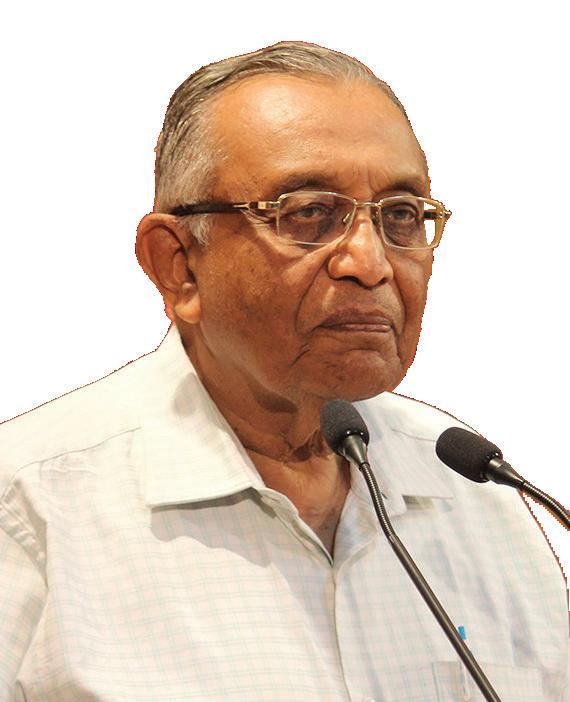
undergone a major transformation. We can call it a paradigm change. The main change that has affected all of us pertains to the application of digital systems of communication of information, sending of pictures, the ways of calculation and the way in which knowledge is stored and retrieved.
The importance of books and periodicals are gradually diminishing. The internet has provided quite a few social media platforms on which millions of people interact with each other or in a group. The transmission of data is so fast that we are in a position to see any event taking place in the world live. Out of the eight billion population of the world, almost 93% are using this versatile gadget. For young people below 20 years of age, a life without mobiles is impossible to imagine. With the advent of digital communication letterwriting, sending telegrams, making money orders etc. have disappeared. Whether it is music or photography, whether it is banking or sending applications, every transaction is happening online.
The use of artificial intelligence and robotics evokes a mixed reaction. Many people are scared to the extent that robotics and AI will destroy many things including the human race. On the other hand, many people believe that such fears were expressed for so many inventions human beings are highly creative and will provide remedies for every challenge they may face.
I cannot forecast the shape of things that will come after 25 years. However, I can say with reasonable confidence that in the next 25 years, children will mature physically and mentally around 15 years of age. There will be greater equality between the genders. The average life span of people in most countries may touch 100 years. People will be working with full vigour up to the age of 85-90 years. There will be much better health through nutrition, control over pollution and following the best health practices by a large number of people. People will be provided with their basic necessities more easily than what they are today. Agriculture, animal husbandry, fishing, manufacturing, mining and
Nigam Limited, Gandhinagar. He held many positions in industry, education, information, water supply, fashion, tourism and rural development during his career. Mr Laheri is working
with many trusts to help poor and needy. He helps many companies to plan & implement CSR projects.
trading would be reshaped. Under the new order, society would be liberal, open and accommodating. Humankind will realise that peace and love are essential pre-conditions for happiness. We have seen, in recent times, that the focus is on the individual, his equality, his freedom and his choice. However, in the foreseeable future, people will realise the importance of family. Those who are spending their time away from near and dear ones will realise that for human beings who are social by nature, isolation of an individual would deprive each one of sanity and happiness.
It was believed that less Government is better government. However, post-World War II bureaucracy in all countries added many functions and acquired greater powers than ever before. Now with the digital revolution a faceless and objective governance is becoming the order of the day. As digital applications cover more and more areas the role of bureaucracy will shrink. The discretion and arbitrary powers would be curtailed to a great extent. The role of government as a provider of services will also undergo transformation as various groups in society would be working in an autonomous environment. If governments can ensure peace, the process of development would get expedited. It would lead to
the enhancement of happiness all around. The role of civil services in the next 25 years should be and would be that of a guide and provide assistance to people.
Over a period of a quarter of a century, people will understand that there is a limit to everything including development, accumulation of wealth, utilisation of natural resources and wasteful consumption. If we consider the role of media in the next 25 years the most important aspect that comes to our notice is that communication will become faster but everyone will prefer brevity and clarity. Newspapers and magazines will have to adapt to the requirements of the readers. I am confident that Gujarat Samachar and Asian Voice will rise to the occasion and, as they have contributed significantly in the last 50 years, they will contribute much more in the next 25 years. I wish them great success in providing a live and useful link between the readers and the world.
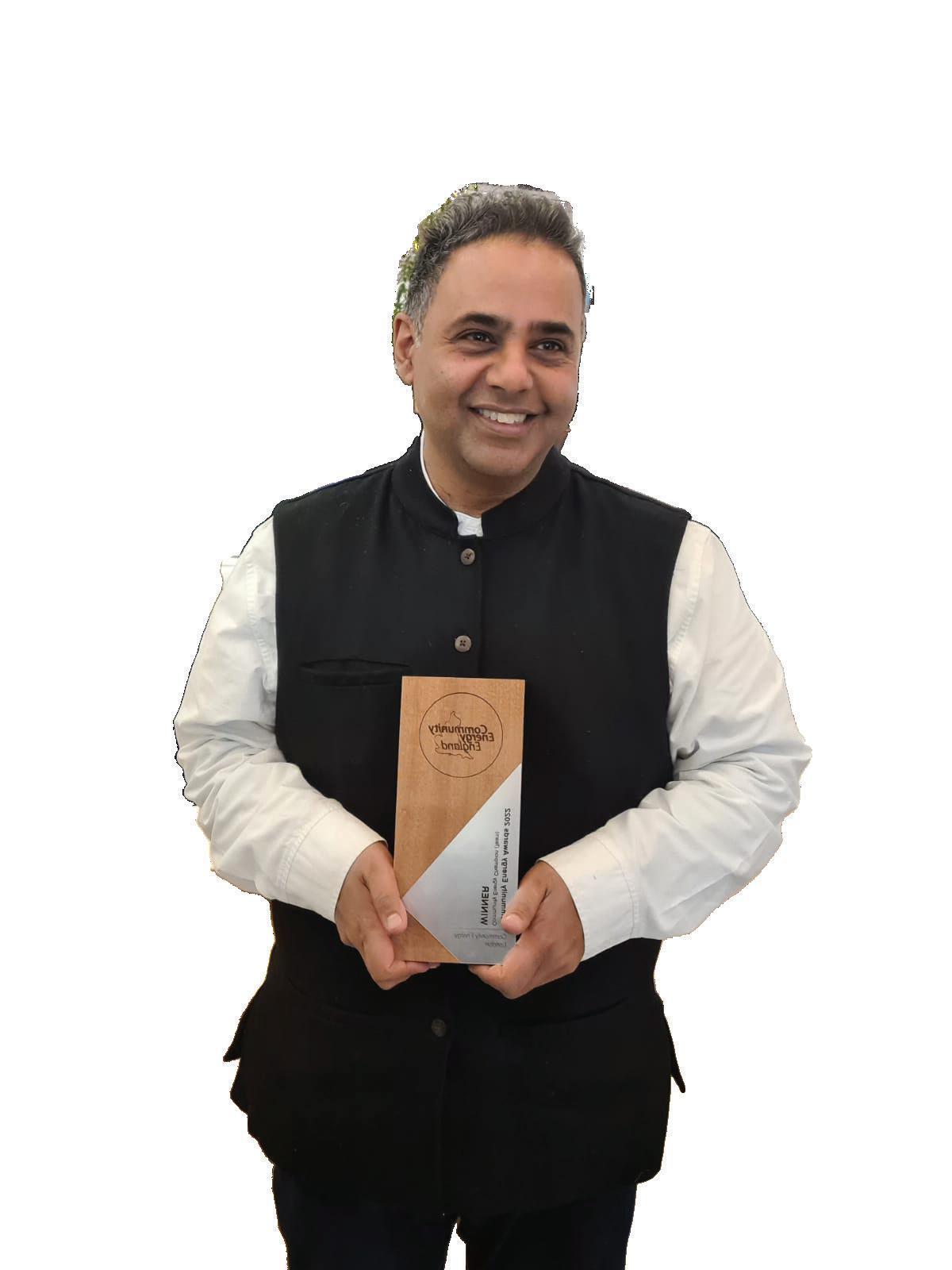
The issue of our use of energy and its impact on the environment is never far away from news headlines, but the past few months have seen it dominate the news cycle, leading to a real polarisation, and politicisation, of what is seen as the best way forward for the country to decarbonise. As the debate rages, the public are presented with new
government announce funding for new nuclear power plants, as well as investing in small modular nuclear stations; ministers tout hydrogen as the best way to replace natural gas and decarbonise our heating supplies, and the Prime Minister has stated we need to invest in Carbon Capture and Storage as a route to bury emissions in depleted oil well released from industrial processes. And closer to choices that can impact us now, topics regularly appear such as ‘will heat pumps keep my home warm’ to ‘how far will an EV take me before it runs out of charge’?
Syed Ahmed OBE is the Chair of Community Energy London. He has over 20 years experience working in the sustainable energy industry with a focus on decentralised energy issues, and the role of cities and climate change. In 2012 he established Energy for London, an independent research and campaigning organisation to support London’s journey to become a Net Zero city.
It is a very confusing landscape –and that’s before we’ve talked about Greenhouse Gas Removal technologies! One thing I am sure of, however, is that not only do I not know what the future energy mix will be over the coming decadesbut frankly – nobody does. Instead, as part of this examination of what might happen over the next 25 years as we strive to achieve our legally binding Net Zero goal by 2050 – I set out what I consider will absolutely need to change if the UK is to achieve its climate and energy ambitions.
We need to be more efficient in the way we use our energy: This is across the board from our homes which have some of the most leaks in terms of heat compared to any of our European counterparts, to public sector buildings, such as schools, museums and hospitals to business and industry, where a lack of investment over many years has not only contributed to the UK’s low level of productivity – but also made meeting the costs of energy supply too high. The focus is all too often about where our next supply options should come from – to ‘max out’ our fossil supplies as the PM has recently stated. Instead, we should turn to how we can best reduce our demand as a key route for not only reducing emissions, but also reducing costs and enhancing our energy security. This route would offset the need for
securing additional supplies, would be quicker and cheaper to deploy and create more jobs as part of large scale building retrofit programmes. As has already been said several timesthe greenest energy is the energy we don’t use.
We need to be smarter in the way we use our energy: Our energy system of ‘old’ was predominantly made up of a handful of large generating plants, mostly burning coal and then gas and nuclear, pumping electricity down pylons to our towns and cities. The last 20 years has however seen a rapid and fundamental change to that model – where we now instead have millions of generators contributing smaller amounts of electricity locally. It makes more sense to generate the power at the point of use through options such as solar photovoltaic cells – rather than hundreds of miles away. But to make such a ‘distributed or decentralised energy’ model work most effectively, we need a smarter more flexible system in place which can track each unit of electricity generated, have the capability to store, and release this power as and when it is required, and for users to interact with the network – moving from being a passive energy customer to a more active one.
The building blocks of a such a system are already in place, from smart meters to batteries to flexible
energy tariffs for consumers, which can flex consumers energy supply needs according to additional –or reduced - wind or solar power output. The transition has, however, only just started: expect smarter appliances in homes, to local supply tariffs from neighbours or your local school, to reverse supply of power from car batteries to the use of AI predictability models and system operations allowing for greater network efficiency. Regardless of whichever generation technology proves to be the most suitable for the UK, a smarter energy system will be an absolute requirement for a future energy system.
We need to ensure future choices work for the public: Finally –whichever clever gadgets and energy technologies prove to be most effective to achieving Net Zero – to succeed – consumers must want them. I believe most of us are willing to accept changes, even some we don’t like, to help ensure our neighbourhoods, and towns and cities are cleaner and greener. The recent shift in the use of the phrase ‘global warming’ to ‘global boiling’, as we see an increased incidence of extreme weather events around the world, is likely to concentrate minds further.
However, simply imposing changes without ensuring routes to support
a fair transition is unlikely to work with the public. There are many cobenefits related to the measures to be implemented when tackling climate change. These range from warmer healthier homes, improved air quality, new opportunities for investment and jobs, and greener more liveable towns and cities. Policy makers and businesses must ensure that they respond to the needs of consumers as these new technology options are rolled out, especially when things go wrong (and they will…); provide funding to support this transition (and this is investing in that change – not merely spending money); and finally provide education opportunities to all those who want to be involved in this multi-decade, countrywide programme to achieve Net Zero.
The month of July this year brought extreme temperatures in parts of the United States of America, southern Europe and China, record breaking temperatures, with 25 straight days of over 43 degrees Celsius in Phoenix, Arizona, reaching the high of 46 degrees Celsius in Italy. Wildfires in Greece and Hawaii and flooding in China and India were visible manifestations of climate change at our doorstep.
The United Nations SecretaryGeneral, Antonio Guterres, reminded the world that the era of ‘global boiling’ has arrived. In a tweet, he reminded that July this year had already seen the hottest three-week period ever recorded, the three hottest days on record, and the highest-ever ocean temperatures for this time of year.
These extreme heat events are likely to occur at regular periods globally. The implications would not be limited to melting snows and rising sea levels. The most obvious impact would be on agriculture, as crops would shrivel in extreme heat or rot in unseasonal heavy rains and cloudbursts.
Ruchi Ghanashyam is the former High Commissioner of India to the UK.With a career in Indian Foreign Service for over 38 years, she has been posted in many countries including South

Pandemics are anticipated to recur at less than the 100-year interval that we saw between the Spanish flu and Covid 19. New diseases and viruses are likely to challenge the global population. According to two scientists of Copenhagen University, the North Atlantic Gulf Stream will collapse, most likely around 2050, causing pronounced cooling of the northern hemisphere and intense heat in the southern hemisphere with catastrophic consequences.
The United Nations Framework Convention on Climate Change (UNFCCC) and Paris Agreement have set out global climate action required to be undertaken by nations. As a party to UNFCCC and in the spirit of multilateralism, India has submitted its updated Nationally Determined Contributions (NDC) on 26th August 2022, translating the ‘Panchamrit’ targets announced by PM Modi at COP-26 in December 2021. India is well on track and has achieved two of the NDCs announced in 2015, much ahead of time, both in terms of share of non-fossil fuel as a source of energy as also reduction in the emission intensity of the economy.
Africa, Ghana, before arriving in the UK. She wasonly the second woman High Commissioner to the UK since India’s independence.
India has gone ahead to further enhance its climate ambitions. To address and combat climate change, as well as to provide a roadmap to achieve net zero by 2070, India submitted its Long-Term Low Emissions Development Strategy to UNFCCC on 14th November 2022. The enhanced NDC is a step towards achieving India’s long-term goal of reaching net zero by 2070. The enhanced goals now stand as follows:
a) Propagate a healthy and sustainable way of living based on traditions and values of conservation and moderation, including through a mass movement for ‘LiFE’–‘Lifestyle for Environment’ as a key to combating climate change, wherein the focus is on individuals making a positive change through their choices and behaviors, vis-a-vis consumption of energy, usage of water, waste disposal etc.
b) Adopt a climate friendly and cleaner path at corresponding level of economic development
c) Reduce Emissions Intensity of its GDP by 45 percent by 2030, from 2005 level
d) Achieve about 50 percent cumulative electric power installed capacity from non-fossil fuel-based energy resources by 2030
e) Create an additional carbon
sink of 2.5 to 3 billion tonnes of CO2 equivalent through additional forest and tree cover by 2030
f) Better adapt to climate change by enhancing investments in priority sectors
g) Mobilize finance from developed countries to implement mitigation and adaptation actions
h) Build capacities, create domestic framework and international architecture for quick diffusion of cutting-edge climate technology
India has also steered international coalitions:
• International Solar Alliance (ISA), launched in 2015, to bring clean and affordable solar energy within reach of all. So far, 116 countries have signed the Framework Agreement of ISA with 94 of them ratifying it.
• On the sidelines of COP 26, India launched “Green Grids InitiativeOne Sun, One World, One Grid” for availability of clean energy from a world-wide grid everywhere at all times and reducing the need for storage and increase in viability of solar projects.
• Coalition for Disaster Resilient Infrastructure and plan to spend USD 50 billion for conservation and development of water resources
• ‘Infrastructure for Resilient Island States’ (IRIS) under Coalition for Disaster Resilient Infrastructure (CDRI) for easy and faster mobilization of technology, finance and necessary information to promote quality infrastructure for lives and livelihoods in Small Island Developing States.
Frequent pandemics, food shortages, rising sea levels inundating coastal areas, intense heat waves and freezing temperatures, cloudbursts, floods and landslides are some of the ways in which nature is likely to assert its fury on humanity. Most of us are blindly hurtling into this grim future, with many not even cognisant of or convinced by these dire predictions. Nations must act with urgent commitment and each one of us must adapt LiFE, to prepare for the coming difficult challenges.
In August 1981 future Indian PM Atal Bihari Vajpayee at Gujarat Samachar offices. On dais from leftShri Satyanarayanji, Sharmaji, Ramanbhai Khatri, Pranlal Sheth and CB Patel.
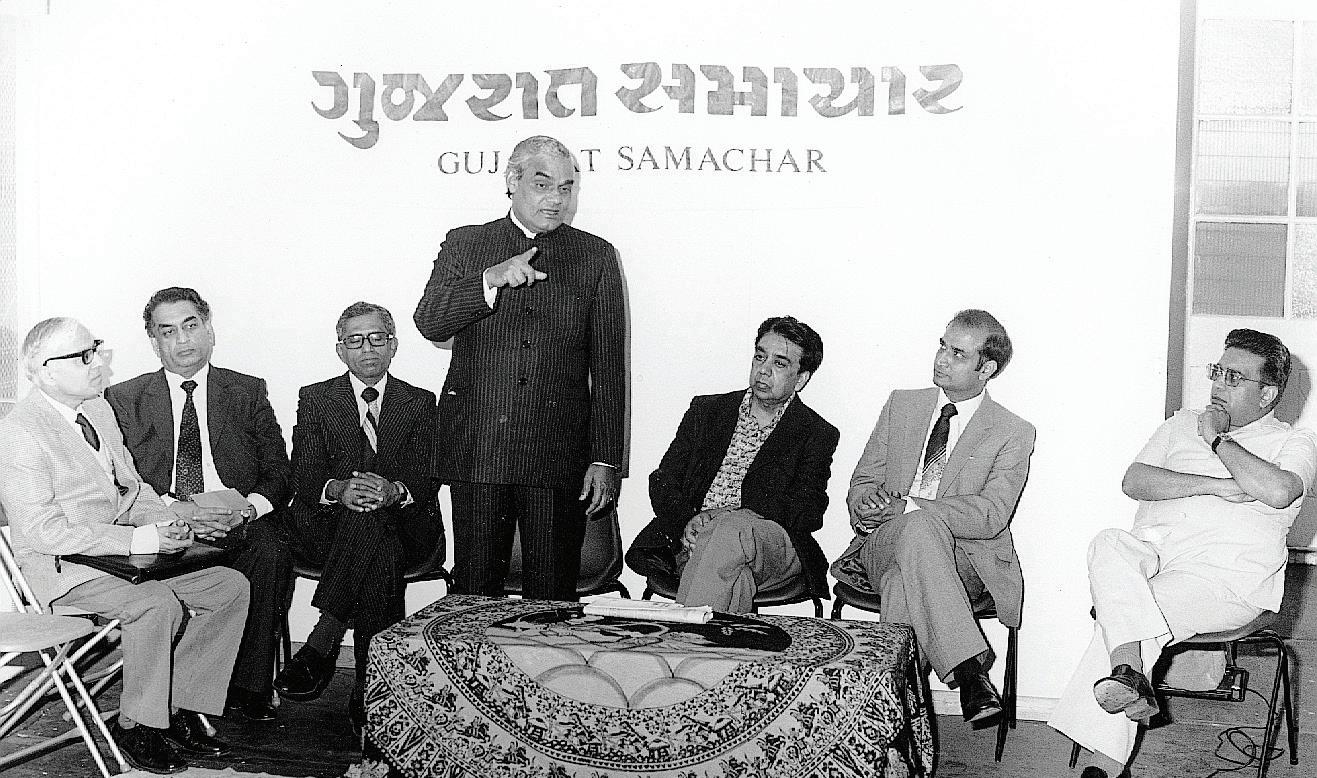
1995 CB Patel in discussion with the then Gujarat Chief Minister Keshubhai Patel during a NCGO function. CB appealed for taking a quick decision regarding Ahmedabad International Airport. Leelaben Patel joined them
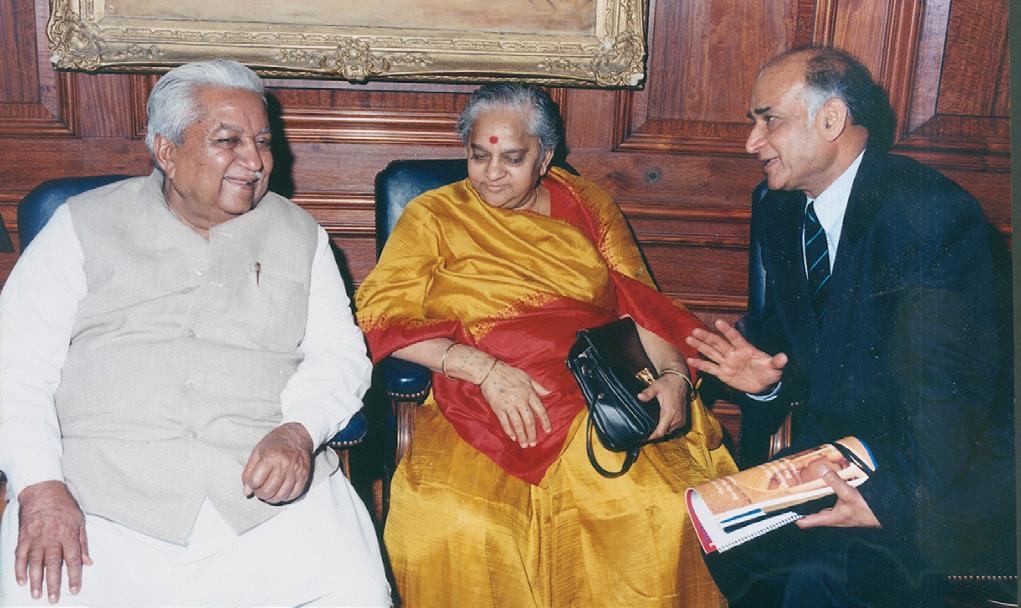
Gujarat Samachar’s first edition (1972)

Despite the hullabaloo about digital media, print media still has a big role to play. The credibility of print media is quite high, especially considering the mushrooming of fake news in the digital media space. Most readers of print media are people in the mid and higher age groups and have more spending time than the youngsters who are more addicted to online news. Although print media is unlikely to boom dramatically, yet it won’t die anytime soon. Although digital expansion is more than print media, still they will never threaten the existence of print media. While a majority of those who read news are joining online, there are still
many who like the print experience.
In addition to sensory aspects, print media is widely considered more credible than digital media. People who subscribe to magazines and newspapers do so for a reason, they believe the information contained in the publication is accurate and credible. Print media is often considered less invasive, with no annoying pop-up ads getting in the way. A brochure, magazine or other form of print is a relaxed form of marketing. Consumers can read the content when they choose, without having their Facebook feed interrupted by an
KK Joseph began his journalistic stint with Indian Express publication in Ahmedabad. After a long stint, he took voluntary retirement from it
and later joined Asian Voice and has been associated with it for more than 15 years now.
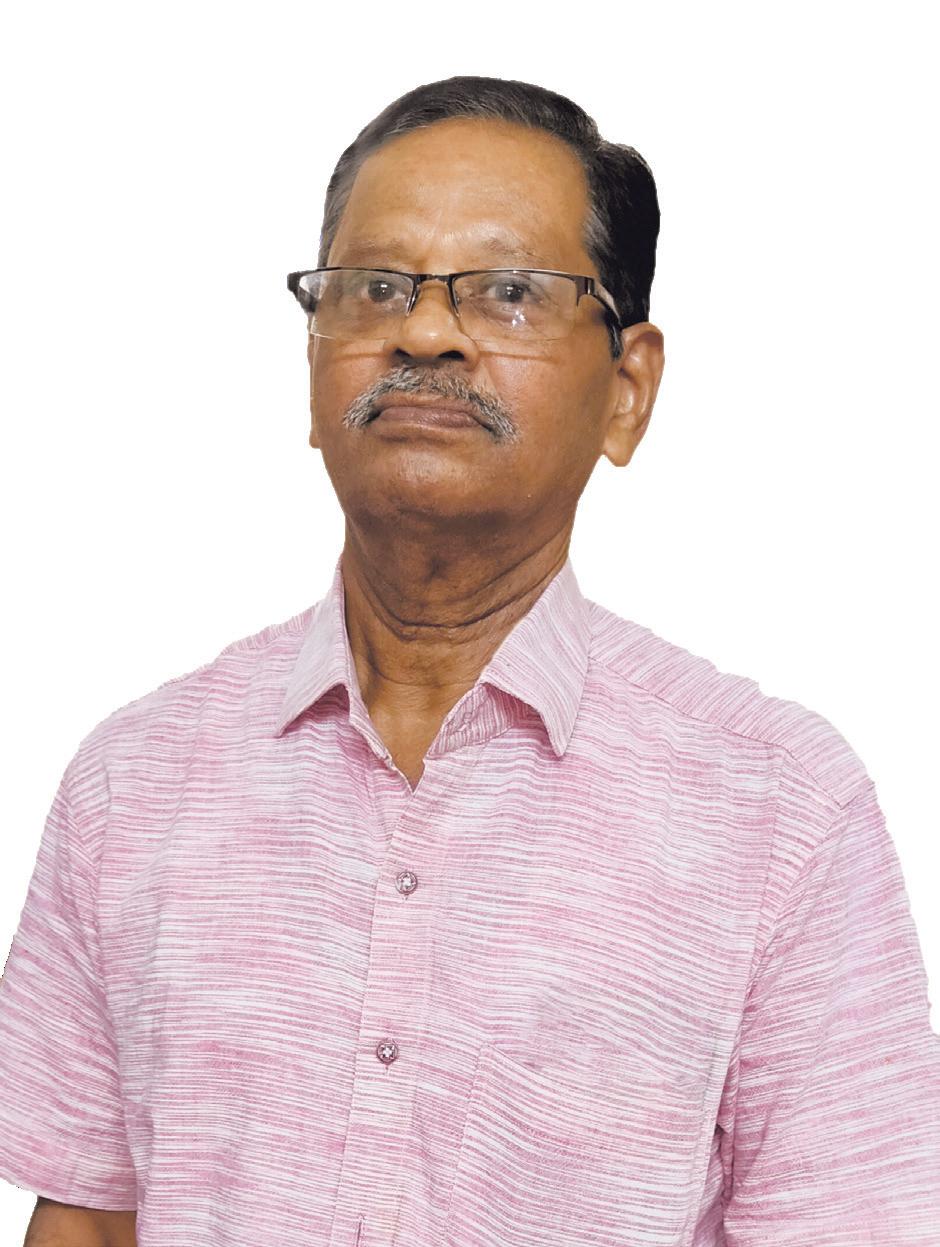
Magazines and newspapers are among options for print advertising. Even with the advent of digital media, magazines and newspapers have barely seen any decrease in readership in the recent past. While watching an online program, most of them try to skip advertisements. There are countless blocker plugins for every web browser that exists. However, in print media, advertisements are part of the experience. Unlike modern technologies, newspapers or magazines do not require internet access to know the latest information. However, print media will have to be innovative and reinvent itself to compete in the uphill battle with the digital space. There will always be people who love the touch, feel and the smell of paper and they will never allow the print to die.
Print can be consumed in an easyto-read format, improving the experience for the consumer and positioning the brand positively. Print allows you to tell a story effectively, helping to support sales pitches and other marketing efforts. When you read a print material, it is more likely to be retained in your memory. Studies show that we are able to retain information, read in print better than when read online. The reason? Because print is tangible
and has impact, the brain is able to process it easily, thus increasing recall. Furthermore, print stimulates a strong emotional response and has a great impact on the reader. Therefore, it is important to include print within your multi-channel strategy.
The print media needs to look at new and innovative ways to survive. A ray of hope comes from Augmented Reality (AR) which uses technology to ‘bridge the gap’ between the digital and the real world, thus preventing potential incurable fracture of the print media. AR technology has the power to unite the best aspects of both print and digital. AR takes the dullness out of the print media and enhances it with audio-visual interactive 3D animations. Digital technologies are no longer a rival to print media when it comes to AR. What is even more interesting is that print campaigns can utilise AR to get an upper hand over their competition. Print media has been battling digital devices with very little success. Yet with AR, it now can utilise these same devices to strengthen and complement print business campaigns. The fight between print and digital will continue for years to come, but the digital revolution can never replace the print. Understanding the importance of both, the brands are now exploring the ways to
complement print advertising with digital marketing by allowing them to work together.
In the present scenario, print media will need to attract young readers for survival. There is a significant gap between young peoples’ interest in news and their consumption of it, suggesting that youngsters expect news to find them, rather than the other way around. Young people seek a personal connection to their news providers, so community coverage may be a valuable investment in future audiences. The design of paper should be attractive with visuals. Another important aspect to take note of, is that newspapers can’t compete with the internet when it comes to news. Their future can’t depend on publishing news which the public already knew. What the newspapers can do is to provide a background analysis on why it happened and what it means to the public. That’s something that adds real value to any publication. The print media can thrive if they provide quality content and real value to their users.
As Gujarat Samachar has completed 50 glorious years in its service to the public, I earnestly wish Gujarat Samachar and Asian Voice a bright future in the coming years.
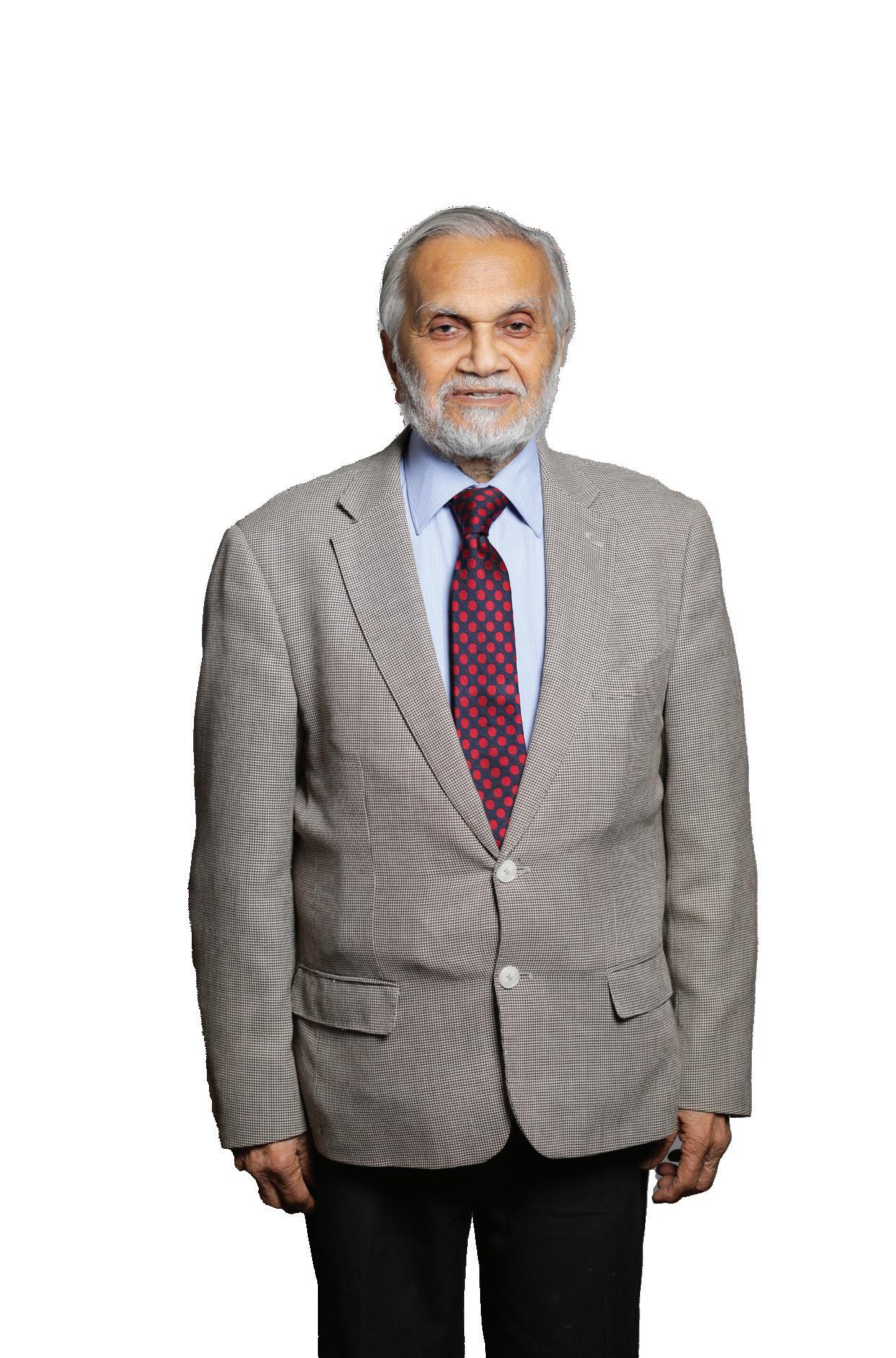
Survival of ethnic media is not easy. It is a difficult task. It must cater to the interests of the relevant ethnic community without becoming inward looking. At the same time it must also interest the wider community and give it useful insights into the views of the ethnic community. Few ethnic papers manage to do both and as a result tend to fold up after a short earthly existence. The fact that the ABPL
This is so partly because ethnic communities are going to grow and partly because people are interested in their ethnic homelands and want to stay in regular touch, something they could not easily do earlier. This task can be done by television and radio as well but they are not generally as penetrating and thorough as the press. The press can summon articles that throw light on complex issues and explain them to its readers in a relatively simple and intelligible manner. All press has such a responsibility, the ethnic press far more so. It needs to play a greater role in the evolution of the ethnic community and become its critical voice commanding public attention and respect.
Bhikhu Parekh is a member of the House of Lords. He has been professor of political philosophy at the University of Hull and Westminster and centennial professor at the London School of Economics. He has written over 12 books, received 18 honorary doctorates and Sir Isaiah Berlin prize for lifetime contribution to political philosophy.”

It must entertain the communities and hold their attention. At the same time it must also educate them about the larger society in which they have chosen to settle and help them come to terms with it. The two roles are not easy to combine. Furthermore the press should also involve its readers in the formation of ethnic opinion on important issues. This is best done through its letters to the editor column as well as articles by carefully chosen authors from within the community and outside. This requires constant dialogue between the ethnic papers and their readers. There are ways of doing so. If the press succeeds in finding them it has a bright future.

I can still recall, almost 50 years ago, watching the newspapers’ one and only elderly typesetter wearing his thick spectacles, moving as fast as he could to composite metal letters onto the large wooden tray for the sheet fed press that printed off the early editions of Gujarat Samachar and New Life (as Asian Voice was known). It was tedious, demanding work, carried out in the mews behind the shop we also ran amidst the noise of
weeks’ issue was printed, there was still more physical work involved in wrapping and labelling each copy for posting to readers.
The next five decades brought huge changes, from the introduction of phototypesetters and hot wax pasteup boards, through to fully digital desktop publishing, but the amount of work never seemed to decrease. On publication and posting day, it was all hands-on-deck, with the boundaries between home and work blurring: evening meals shared with office colleagues; my mother seamlessly switching from catering for the staff to physically wrapping
Merul Patel, PhD is CB and Pushpa Patel’s son. A Cambridge educated PhD Physicist, he has worked for almost 30 years in information technology, several of which for the family publishing business, and for the last 16 years in environmental sustainability.

each newspaper; my aunt typesetting late into the night before driving staff home in the early hours; and my father running from event to event and back to the office to coordinate the entire operation.
Both Gujarat Samachar and New Life were essential at helping keep the British Asian community informed and involved in the things that mattered to them, be it their religious freedoms and access to temples, like Bhaktivedanta Manor, or stories related to racial discrimination in the UK or domestic Indian politics. As the readership grew, we outgrew our black and white, sheet-fed press and single mailing line, and outsourced the same to full colour presses and fulfilment houses used by national and local publishers.
Over the last 20 years, the pace of change has continued to accelerate, and it’s not just to how our papers are produced. The internet has become essential to everyday life, and readers can get real-time updates on the news that matters to them from any number of news websites, WhatsApp groups and other social media. British Asians are present at all levels across all fields and professions, and we punch far above our weight as a percentage of the population. We also have 4th and 5th generation
descendants, many of whom have integrated and married outside of their original communities.
The world has also changed beyond recognition over this period, with global supply chains and international travel shrinking the planet, and global events spreading –literally – at the speed of light.
So, is there a need for Asian Voice and Gujarat Samachar now? With the huge deluge of online sources available, people are increasingly eschewing stories they don’t like and spending time in social media echo chambers. The need for curated, trustworthy news is greater than ever before, and editors have a vital role in ensuring communities continue to engage with each other, and not split into factions, especially as beliefs and priorities change.
But Asian Voice and Gujarat Samachar will also need to evolve as the world shrinks. Climate change is no longer deniable – if it ever was IMHO. Two years of the pandemic, the Russian invasion of Ukraine and our self-inflicted Brexit have brought on wave after wave of industrial action and unprecedented financial hardships. The publications will need to help readers deal with all the resulting
uncertainty, and help the debate on how to address the issues that affect us all and also to reprioritise what’s important. When the world is on fire, environmentally and geopolitically, is a direct flight from Ahmedabad to London Heathrow that important? When religious extremism risks destabilising global peace, should we not help lower the temperature of the debate, both at home and the motherland? As descendants of immigrants, should we not remind our political representatives of the value that we have brought and the importance of keeping the door open?
repercussions. The British Asian community needs to engage with these quickly, to ensure racial discrimination does not find its’ way into the digital and medical worlds.
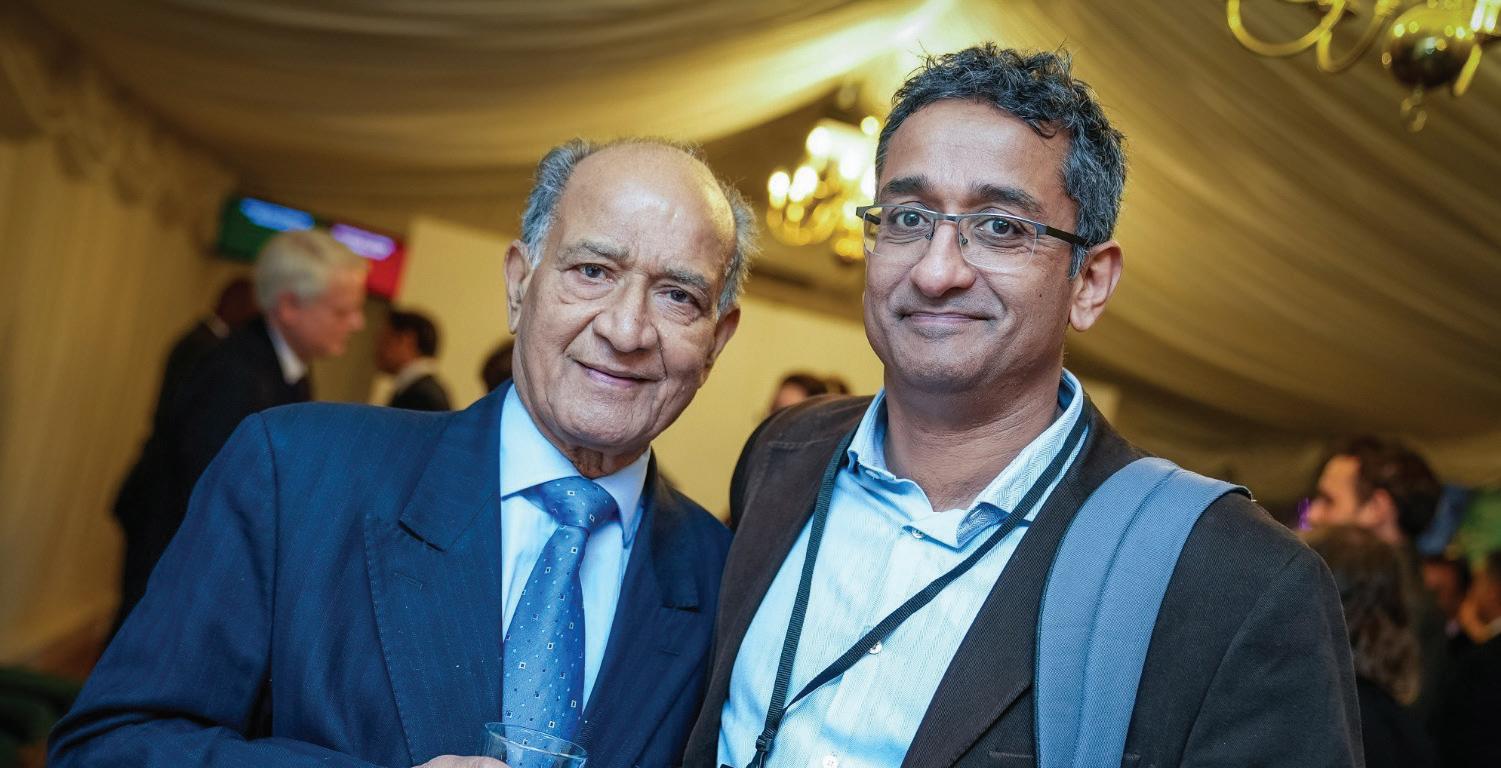
I would never say that we had a normal family life at home, but not everyone can say they’ve been able to not just witness but also document and, in an albeit small way, shape the agenda. Asian Voice and Gujarat Samachar have travelled many miles but still have a way to go. I’m looking forward to seeing what the future holds!
The future is also imminently bringing new possibilities, with the advent of artificial intelligence (I prefer to call it Machine Learning) and genetic therapies, which will extremely rapidly have far-reaching
The future of any industry is closely bound with wider forces - no industry is a self-sufficient island insulated from the rest of the world. For instance, worldwide publishing benefited from globalisation after the end of WWII. By contrast, publishing in the UK has suffered because of Brexit. And worldwide publishing suffered as a result of Covid.
Though the end of the pandemic restored the fortunes of publishing worldwide, there remain three challenges. One, fewer and fewer people seem prepared to exert their minds on anything much
more substantial than tweets, blogs and games; second, ChatGPT and subsequent generations of AI (“Artificial Intelligence”) threaten to swamp the market with mediocre material. Finally, the RussianUkrainian War continues to disrupt logistics and cause a shortage of paper.
However, in the case of India, at least
Prof Prabhu Guptara is the Publisher of Salt Desert Media, which has two imprints: Global Resilience Publishing, whose focus is on global challenges; and Pippa Rann Books, whose focus is on India and the Indian diaspora.
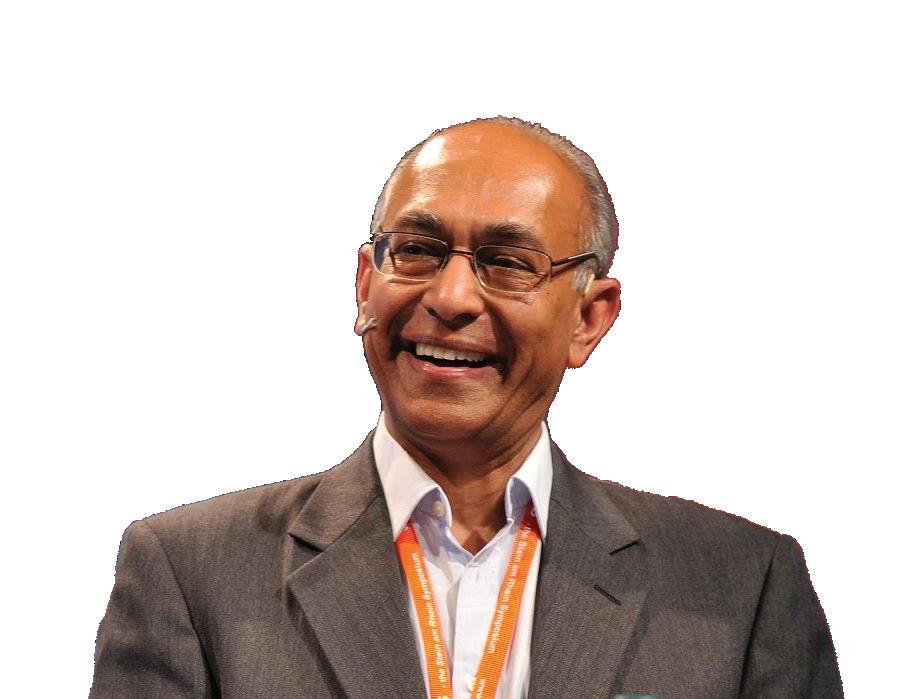
The first factor is whether India’s massive and still-growing population (already the largest in the world), will become a demographic blessing or a demographic curse.
That depends on which model of development we now choose. Initially, in India’s first Five-Year Plan period (1951-56), India followed the model of “feeding the poor little starving younger child” - by which I mean the agricultural-rural sector (prioritising investment in health, education, and infrastructure, especially for our villages). However, from 1956 onwards, India reversed the model, extracting resources from the rural sector to feed the “elder child” – we switched investment to the industrial-urban sector.

In both models, we all know that much of our national budget was squandered due to poor planning, and much disappeared due to corruption. Though we have now extended our historically poorquality roads to many areas of the countryside, investment right across our nation has fallen, both in health and in education.
of the Buddhist and Jain mind in the 9th century AD, India saw no significant intellectual advance till the end of the 19th century. That is when, as a result of the labours of William Carey and others, the Indian Renaissance finally started. Of course, the Renaissance was not initially a mass phenomenon in any location. Nor was it widely spread across the land. But it did represent a new start. And the ripples of the Renaissance continued to expand till recent years, even if we were dogged by issues such as the emergence of millions of “unemployable” schoolleavers, graduates and postgraduates - partly because of the poor-quality education offered in many of our educational institutions, and partly because the economy did not expand fast enough to utilise the talents of a sufficient number of our “employable” graduates.
That takes me to the second factor: the quality of the Indian mind. Since the time of Shankaracharya’s elimination or marginalisation
Today, however, we are faced with a re-narrowing of the Indian mind. For one thing, we are overemphasising STEM (Science, Technology, Engineering and Mathematics). What is wrong with that? Simply that a highly trained scientist, technologist, engineer or mathematician can turn her or his talents to selfish ends or to philanthropic ends, to fair ends or to unfair ends, depending on whether
he or she has a positive social and moral commitment and indeed a historical perspective.
In the quest of glorifying our past, we have been narrowing any possibility of genuine historical understanding by simply eliminating parts of our history from being studied at all.
Morally, we place undue reliance on yoga and meditation, which are great things in themselves, but we must not forget that Hiranyakashyapa and Ravana could enhance their power as well as their crooked intelligence by meditating, praying, and doing yoga. In other words, in our tradition, yoga, meditation and even prayer don’t have any necessarily positive moral dimension.
That is why we need to find ways to enrich our education with much more history, morality and ethics than we are currently doing. Is it any wonder that the world-class idealists, working for the good of the nation, who filled our Parliament at the time of Independence, have been replaced by such a large number, belonging to all political parties, of convicted criminals or those with criminal cases against them in courts, who are members of our current Parliament?
I am sure you will not be surprised by my conclusion that India, and publishing in India, will flourish to the extent that corruption is not merely centralised but eliminated, a spirit of public service is inculcated once again and the quality of education is improved, resulting in an increased desire and drive to expand the Indian mind.
After all, what worthwhile objective does Indian publishing serve, if it does not help to eliminate corruption, nurture a spirit of public service, improve the quality of education, and expand the Indian mind?
In 1981 PM Margaret Thatcher made her first official visit to India. Gujarat Samachar and New Life ran a campaign against PM’s immigration and nationality bills. A petition was signed by over 32000 people. On the eve of PM’s departure, CB discussing the issues with her at the official residence of the Indian High Commissioner, Dr Saeed Ahmed. CB was the first Indian origin journalist to accompany British PM to visit India
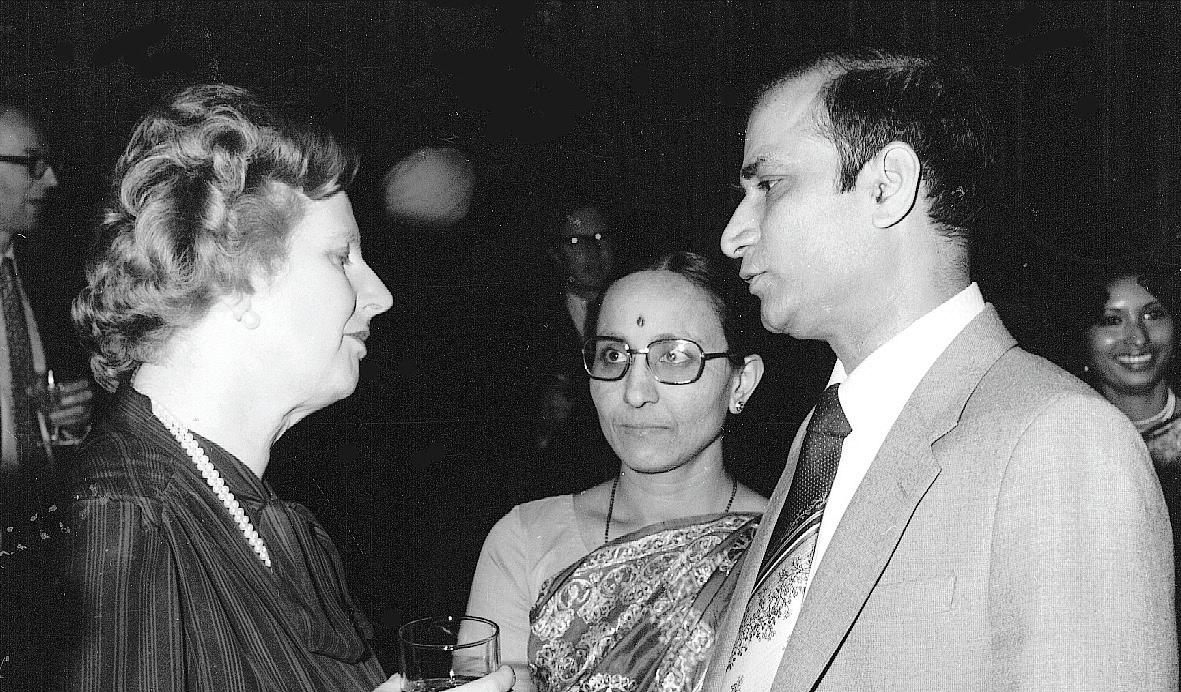
Politician and Actress, Smriti Irani visits the office while she is in London for her ‘Maniben dot com’ drama. She was honoured by Sarojben Patel, Director, ABPL Group
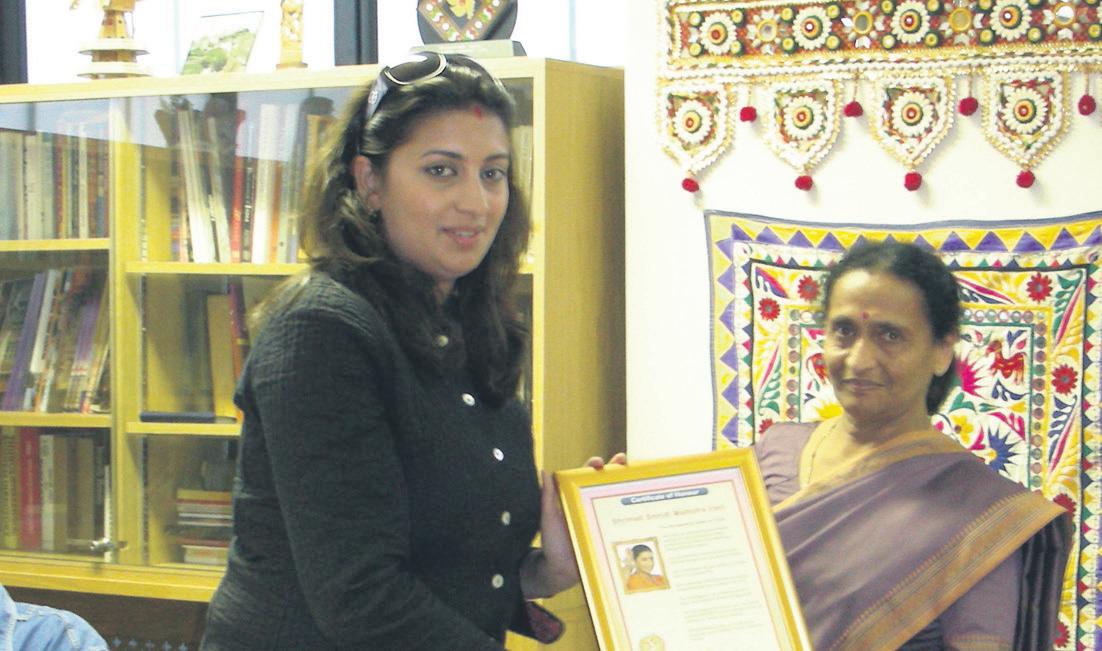
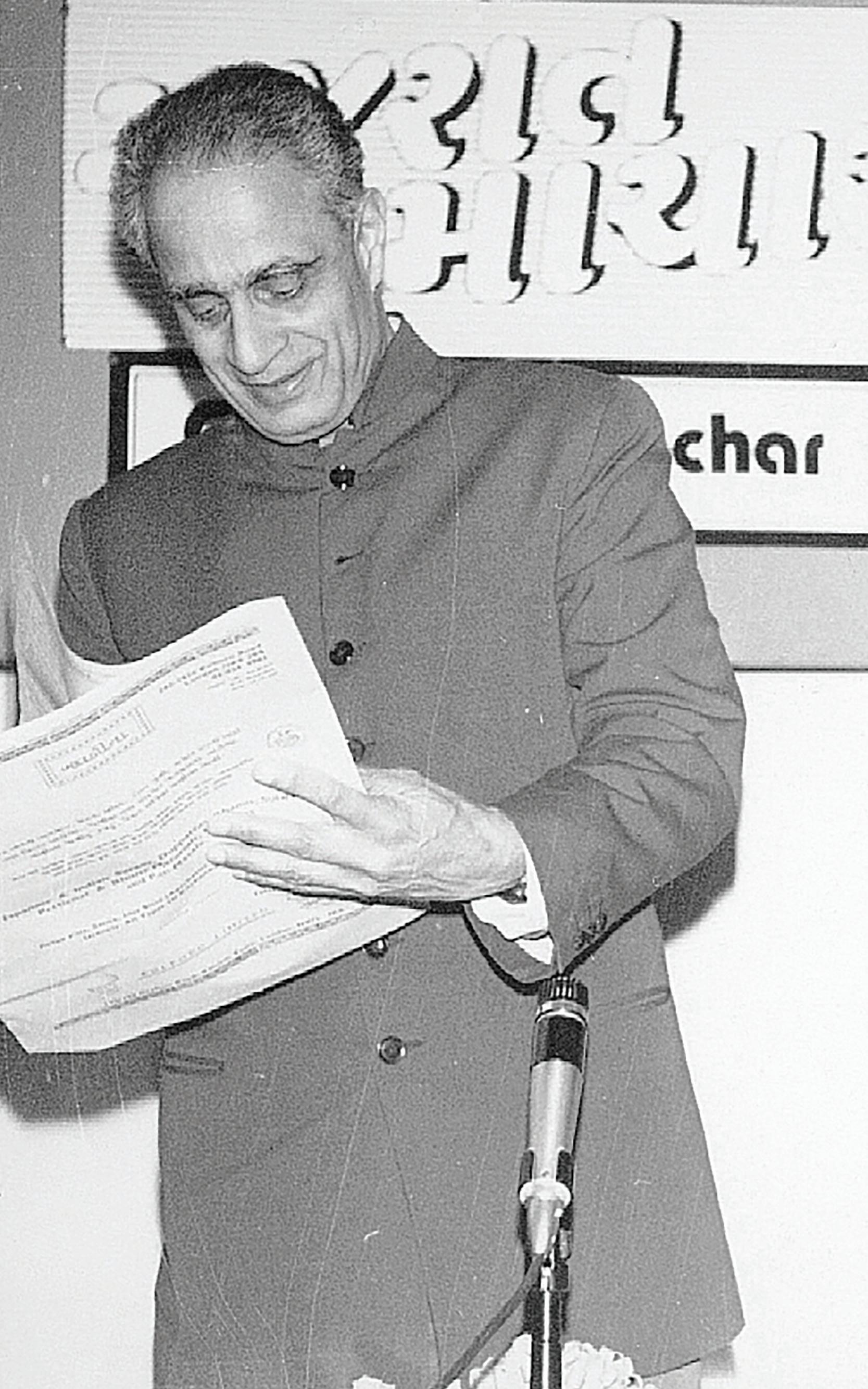
In the words of Swami Vivekananda, “Arise, awake, and stop not till the goal is reached.” As we stand at the precipice of a new era, the relationship between the United Kingdom and India is poised to embody this spirit of relentless pursuit and mutual growth.
The UK and India, two vibrant democracies and leading economies, are embarking on a journey towards a Comprehensive Strategic Partnership (CSP). This partnership, guided by the 2030 Roadmap, is a testament to the shared history, values, and culture that bind our nations together. It is a living bridge, built on the strength of 1.6 million Britons of Indian origin and the
dynamic Indian diaspora in the UK.
The next 50 years promise a quantum leap in this relationship, with cooperation spanning health, climate, trade, education, science and technology, and defence. The roadmap is not merely a plan; it is a shared vision for revitalised and dynamic connections that improve the lives and livelihoods of our citizens.
Health security and pandemic resilience form a crucial part of this vision. The UK and India are committed to strengthening international
Alpesh Patel OBE is a successful investor and a global speaker. He is a former Visiting Fellow in Business, Corpus Christi College and Oxford University. A barrister and TEDx speaker, he is the Co-founder, UK Chapter of the world’s largest entrepreneurs mentoring organisation TiE.org.

supply chains to ensure critical medicines, vaccines, and other medical products reach those who need them most. The OxfordAstraZeneca vaccine, currently produced by India’s Serum Institute, stands as a beacon of our shared fight against the global pandemic.
Climate change is another area where the UK and India are joining forces. We are committed to accelerating the development of clean energy and transport, protecting biodiversity, and helping developing countries adapt to the impact of climate change. The next half-century will see the UK and India leading the world in climate action and clean energy.
Trade and economic relations are set to flourish, with the intent to negotiate a Free Trade Agreement aimed at doubling UK-India trade over the next decade. This economic growth will be driven by the impressive advances and capabilities in human resources, manufacturing, innovation, science, education, research, fintech, space, defence, emerging and green technologies, and clean energy
The future also holds increased cooperation between British and Indian universities on crucial research in areas like health,
emerging technologies, and climate science. Our defence and security cooperation will bring a more secure Indian Ocean Region and IndoPacific, with our navies and air forces undertaking joint training exercises.
The future of UK-India relations is not just about government-togovernment cooperation. It is about the connections between our people, our societies, and our businesses. It is about the Indian diaspora in the UK contributing to the UK’s multicultural fabric and the British businesses investing in India’s growth story.

In the spirit of Swami Vivekananda, we must arise and awake to the opportunities this partnership presents. The next 50 years will see the UK and India crafting a new legacy, one that is hopeful, inspiring, and beneficial for both nations and the world at large.
Joint Mars Mission: The UK and India could potentially collaborate on a joint mission to Mars. The UK has expressed interest in being part of manned missions to Mars and has a deepening relationship with India in the field of space exploration. India’s Mars Orbiter Mission 2, also known as Mangalyaan-2, is a testament to India’s capabilities in interplanetary missions. A joint mission to Mars
would be a monumental achievement in the UK-India partnership.
Collaboration in Lunar Missions: The UK could offer its “very nimble and effective space industry” to assist India in its upcoming lunar missions. This collaboration could pave the way for more significant joint ventures in space exploration, including potential manned missions to the moon.
Space Cooperation Fund: The UK has set aside £80m for an international space cooperation fund for emerging powers, which India can apply to. This fund could facilitate joint space exploration projects, further strengthening the UK-India partnership in space technology and research.
Joint Climate Action: The UK and India could lead the world in climate action and clean energy. They could jointly develop innovative solutions for clean energy and transport, protect biodiversity, and help developing countries adapt to the impact of climate change.
Health Security and Pandemic Resilience: The UK and India could work together to strengthen international supply chains for critical medicines, vaccines, and other medical products. This collaboration could lead to a more
robust global response to future health crises.
Education and Research Collaboration: British and Indian universities could increase cooperation on crucial research in areas like health, emerging technologies, and climate science. This collaboration could lead to groundbreaking discoveries and advancements in these fields.
Defence and Security Cooperation: The UK and India could increase their cooperation in defence and security, leading to a more secure Indian Ocean Region and Indo-Pacific. Joint training exercises between their navies and air forces could become a regular occurrence.
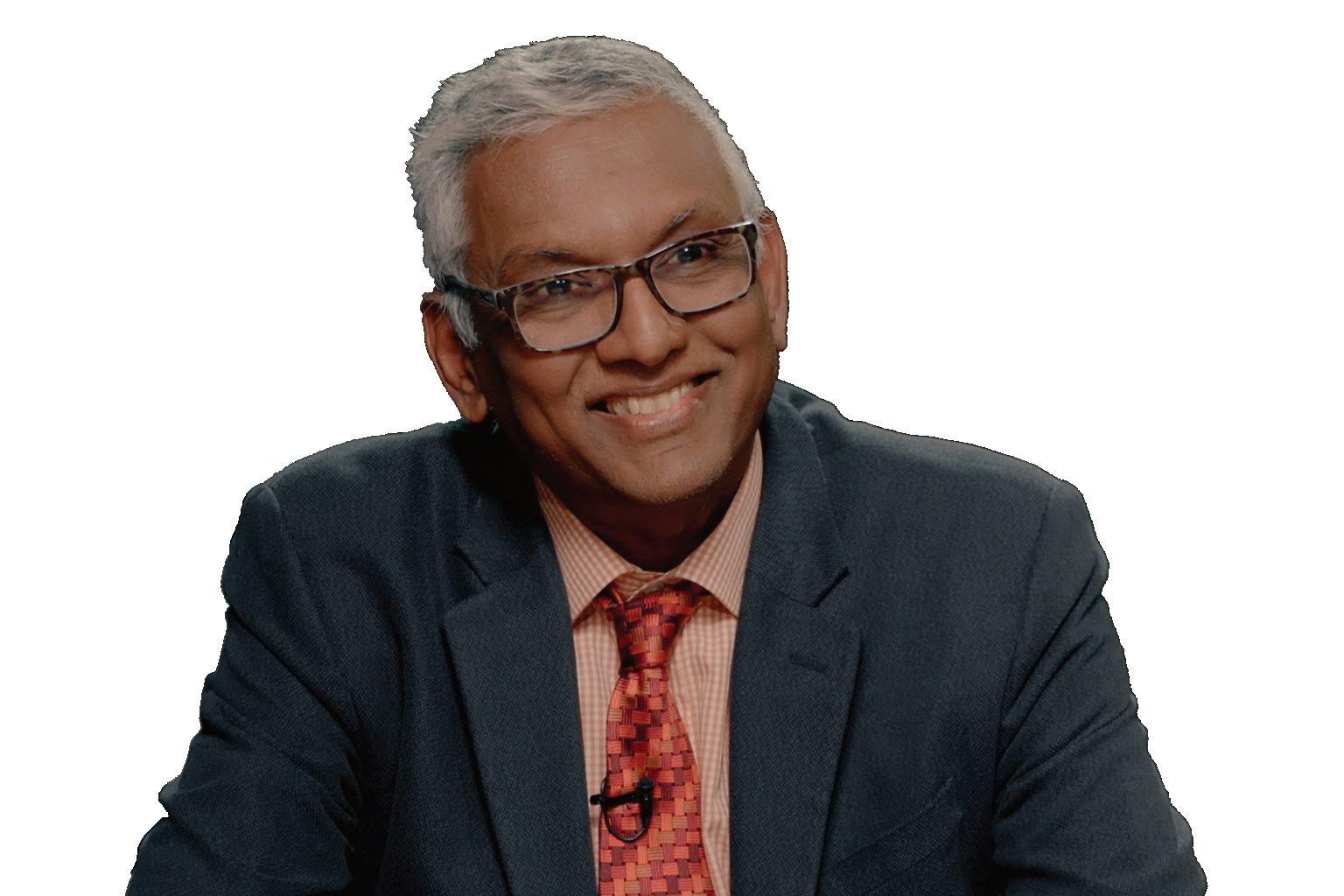
The global pandemic and climate crisis have clearly signalled that we have no other option but to course correct. Seventy percent of all fossil fuel emissions come from twenty multinational corporations. We are consuming 400 billion animals a year on this planet. A secret ingredient in all this is finance. Its power is invisible but its ability to encourage widespread attack on animals and the environment, including the creation of increasing human inequality is shocking. This is unsustainable
One of the unique contributions of Indian commercial history to the world is how business has been built on a win-win philosophy where money is a medium rather than a master. In fact, entrepreneurs had long understood that wealth should flow and enable a kinder, more equal society, and saw finance as a means to peaceful trade and wellbeing. Kings and queens used their status and influence to look after their citizens and understood the huge responsibilities that come with power. So did successful entrepreneurs. Through Dharma they often self-regulated their behaviours. We must revive this wisdom for our future harmony with all living beings.
The education and training in business and finance needs to recall such legendary historical narratives of seva, humility and generosity. For entrepreneurs, purpose was more important than profit and from my latest book tour of India I saw many examples of this even today hiding in plain sight. True stories and narratives are very powerful teaching tools even when they have disappeared from the materialistic and functional business classroom. Stories are never confined to one subject but show the interaction between the entrepreneur and their conscience, community and honour.
Ethical Finance case studies can showcase the power of meaningful enterprise which the world has lost today. Walking recently in old Mumbai in the Fort area, I could feel the past ethical spirits of entrepreneurs so vividly- there are six fire temples (Parsees), six Jain temples on just one street in Kalbadevi and stories of Baghdadi Jews and their educational philanthropy or the Masjid Bazaar as a hub for trade and exchange abound. One of the first things that entrepreneurs built upon achieving success was a temple or shrine and help one another by coming together. Community was never taken for granted but actively nurtured and celebrated. Interdependence was never a theory but instead a lived
experience and a source of joy and fulfilment. Social responsibility was a duty, never a choice.
As India leads the 2023 G20 we need to give the reform of business and professional education top priority. It is in all our interests. Without this, our future is unsustainable. We will discover that there is no fun in being rich in a dying world. India ought to show a different way to the world and explain how trade can be both personal and joyful. Finance needs to be put firmly in its place. The whole planet is indeed one family for sharing and caring, and not for selfishness and extraction. Business urgently needs to change its equations.

‘Without question, the future will be unashamedly African’, declared the editor of Nigeria-based journal The Republic recently. Doubtless, few in Asia would agree with the statement, but if population expansion is the reference point it is fully justified. This is a reality which ‘Asia’ – India and China in particular – appear to have recognised far better than Western nations.
The global population is set to be four times larger in 2050 than in 1950, according to the middleof-the-road projection of United Nations demographers. In the same timeframe India’s headcount will have multiplied by about four times, and Mexico’s by a factor of six.
Africa will be 11 times more populous. In 1980, one in every 10 people in the world was African. Today, it is one in six. By 2050, the continent will account for 25% of a global total of 9.5 – 9.7 billion. In the second half of the century, Africa’s global share will rise further as the populations of most of its 54 states continue to grow and those of East Asia, Europe and North America age and, in some cases, shrink. It is plausible that an African child born today will witness their continent being home to one in every three members of the human race.
Africa’s population mega-surge since the 1950s is the product of life expectancy rising from less than 40 to more than 60 years, coupled with persistent high fertility rates in many East, West and Central African countries. By mid-century, there will be more Nigerians than Americans as the West African behemoth moves into the global number three spot behind India and China. Ethiopia and the Democratic Republic of the Congo (DRC) will join Nigeria in the global top ten. The populations of both Eastern and Western Africa will each have soared past those of Europe or Latin America by 2050.
While Elon Musk and others may decry low and rapidly declining birthrates in the West as ‘one of the biggest risks to civilisation’, there is no ‘baby bust’ on the horizon in Africa. In the 2020s, about 450 million babies will be born in the continent; in the 2040s, the figure will exceed 550 million.
The most striking feature of African demography is what has been termed its ‘chronic youthfulness’. The median age is below 19, more than 10 years less than that of Latin America or Asia (and 20 years less than Europe or China). About twothirds of Nigerians are under 25, and 45% are children under 15. This youthfulness is often depicted as if it were a new phenomenon. Not so
– the median age has always been below 20 and will rise only to 24 over the next three decades. Already, African children are more numerous than the total populations of the US and Mexico combined.
The diversity of African demography is as striking as its youthfulness. The total fertility rate (TFR) in South Africa, Morocco, Libya and Tunisia is at ‘replacement level’, a little above two births per woman, whereas Nigérienne women have seven children on average. In most of the world more female education has been associated with lower fertility, but in Nigeria, even among women who have completed secondary education the TFR is almost 4.5; among secondary-educated girls in DRC it is almost six. Ghana is widely considered a continental leader in the education of girls and women’s usage of modern contraceptive methods is among the highest in Africa. Yet the TFR remains close to four, just one birth lower than in the 1990s.
Similarly, there are as many exceptions as conformers to global ‘rules’ that richer women and urban women want fewer children. Angolan women in the richest quintile have four children on average, in DRC almost six, in Uganda and Nigeria almost four. In Addis Ababa women may have
fewer than two children on average, but in urban Nigeria, the TFR is 4.5. Substantial demographic variation between (and within) countries underscores that for Africa, even regional generalisations are usually misleading.
Demography alone is not destiny, but sheer weight of numbers underscores that ‘Africa, for better or worse, is more important than ever’, as a Washington Post blogger put it. The continent’s geo-political significance and agency in international affairs are rising. By mid-century it will account for one-third of the world’s entire working-age population. The impact of African countries, individually or collectively, will be discernible in almost every facet of life, from global trade patterns to fashion trends, to literature, sport, film and technology. This prospect should not be met with portents of doom or manic cheerleading, but with keener attention and more nuanced interpretation. It is time for the rest of the world – governments and citizens alike – to recognise the growing centrality of Africa to world affairs. Its marginalisation is untenable. Opportunities abound.
I have been fortunate to know Mr CB Patel from the day I started in business and founded Cobra Beer, over three decades ago. In fact, his son, Merul, was a good friend of mine at Cambridge University, where we were contemporaries, he was at Trinity College and I was at Sidney Sussex College.
At the outset, I knew that CB Patel was a leading figure in the Asian community and a leading figure in the field of publishing
UK, with two flagship publications Gujarat Samachar and Asian Voice. He always showed me, from the time I was a young entrepreneur, with all the odds stacked against me, starting from scratch, building a beer brand ‘Cobra’, against all the odds - huge kindness, encouragement and support. I cannot express how much that meant to me and how much it helped me in those hugely challenging, early days.
It is a matter of great pride for all of us to celebrate APBL Group’s 50th anniversary and Golden Jubilee - a phenomenal achievement. Looking
Lord Karan Bilimoria is the founder of Cobra Beer, Chairman of the Cobra Beer Partnership Limited. He is the Founding Chairman of the UK India Business Council, a Deputy Lieutenant of Greater London, a former Chancellor of Thames Valley University (now the University of West London). He was also the President of the Confederation of British Industry (CBI)

back, when CB started in 1973, we are reminded of what a different country the UK was, with the enormous prejudice he would have faced as well as there being a glass-ceiling, Britain was a country with an economy that was floundering and was termed the ‘sick man of Europe’.
Entrepreneurship, and CB was an entrepreneur, was looked down upon. CB and his publishing companies’ journey over the past half a century, has been a journey of transformation for the UK, in which he has played a part, stepby-step, in a country which opened up its economy in the 1980s, which started to encourage, support and celebrate entrepreneurship. A country that provided opportunity for all, regardless of race, religion and background – a country that is now the 6th largest economy in the world, with less than 1% of the world’s population. To think that when CB started in 1973, there was no Asian Parliamentarian, it was only in 1977, that Lord Chitnis was made a Peer and as it so happens Lord Chitnis, was a university contemporary of my mother at the University of Birmingham in the 1950s.
Over a decade later in 1987, the first four ethnic minority Members of Parliament were elected to the House of Commons since the Second World War, making it a total of five
ethnic minority Parliamentarians. In 2012 – we had a picture taken on the steps of Westminster Hall of all 69 ethnic minority Parliamentarians from both Houses and in 2019, after the election, there were 100 ethnic minority Parliamentarians. We have come a long way in the last 50 years and yet we have a long way to go, as 100 is still half the proportion of ethnic minorities in the country. On the other hand, we now have the first British Asian Prime Minister of the UK and have had several key cabinet ministers who are Asian. The Asian community in the UK is reaching the very top, in just about every field including business, media, financial services, the arts and sport.
Looking ahead, the best way to predict the future is to look to the past. I am confident that the APBL Group will have an equally exciting and transformational half century ahead. When it started, we had the Cold War with two superpowers, the USA and USSR. Today, Russa is not even a top 10 economy in the world and there are two super powers; the USA and China with a third emerging superpower, India. India has just overtaken the UK to become the fifth largest economy in the world. As I said, when I concluded my speech in the House of Lords debate on the relationship between the UK and India on 23rd January 2023, ‘’as a boy, Narendra Modi sold tea at his
father’s tea stall at a railway station in Gujarat. Today he is one of the most powerful people on this planet as Prime Minister of India. Today India has the presidency of the G20. Today India has a vision to become, in the next 25 years, the secondlargest economy in the world with a GDP of $32 trillion. The Indian express has left the station. It is now the fastest train in the world—the fastest-growing major economy in the world. The UK must be its closest and most trusted friend and partner in the decades ahead’’.
With India’s rise in power, I see an even more prominent role for the APBL Group in the decades to come. The 1.6 million people of Indian origin in the UK, are the living bridge between the UK and India and the APBL group is a crucial pillar of that bridge and will play an important role in the future of the relationship between the UK and India. I wish CB Patel, his team and all at the APBL Group, at Asian Voice and Gujarat Samachar, every success in the next half century ahead and I take this opportunity to thank him from the bottom of my heart, for all that he has done for me and for our community over all these years.
As the world progresses, the African continent has begun to emerge as a powerhouse of untapped economic potential. With its vast natural resources, youthful population, and growing middle class, the continent presents an opportunity for investors and trade partners to engage in mutually beneficial partnerships. The UK is one such partner with a long history of ties with Africa, and a renewed focus on a trading relationship between the two regions could unlock tremendous opportunities for both. As the Prime Minister’s Trade Envoy to Uganda, Rwanda and DRC I have seen firsthand the opportunities Africa has to
offer to British companies. The UK is also taking steps to address the trade barriers that exist. Last year in Uganda, I announced that the UK is reshaping trade with developing countries by launching a trading framework: the Developing Countries Trading Scheme (DCTS). The DCTS will be one of the most generous sets of trading preferences of any
Lord Dolar Popat is a Conservative Peer and is the Prime Minister’s Trade Envoy to Uganda, Rwanda and Democratic Republic of Congo. In previous roles, Lord Popat has served as a Minister of the Crown with responsibilities for the Departments of Business, Innovation and Skills, and Transport, as well as a Lord-in-Waiting as a member in the Royal Household of Her Late Majesty The Queen.

Uganda are eligible for duty-free access to the UK. This new scheme demonstrates the UK’s commitment to building long term, mutually beneficial relationships.
The decision of the UK to leave the European Union has created a unique opportunity for the UK to strengthen its economic ties with Africa. With the African Continental Free Trade Area (AfCFTA) set to create a single market of 1.3 billion people and a combined GDP of over $3 trillion, Africa is poised to become a major player in global trade and investment. As the UK looks to redefine its place in the world post-Brexit, Africa represents an attractive partner for the future.
The African continent is home to some of the fastest-growing economies in the world. According to the World Bank, the continent’s GDP grew by 3.4% in 2021 on average, with several economies growing at a much faster rate. This growth is being driven by a combination of factors, including rising investment in infrastructure, improvements in governance and economic management, and the emergence of a more connected, tech-savvy population. With these trends set to continue, Africa will rise to become a global player and lead the way in growing its economies.
One key area of focus for trade between the UK and Africa is agriculture. Africa is home to vast tracts of arable land, and its agricultural sector has the potential to meet both local and global food demand. Additionally, there is a growing interest in sustainable and organic farming practices, which could provide opportunities for UK businesses to export products and knowledge to Africa. For instance, the UK could export its expertise in agricultural technology and irrigation to Africa, helping farmers to improve yields and quality while minimizing waste.
As the UK moves towards a green economy and seeks to strengthen its supply chain security, critical minerals are increasingly in demand. Africa is rich in critical minerals, which are essential to produce advanced technologies such as electric vehicles, wind turbines, and smartphones. As the demand for these minerals continues to grow, Africa presents an immense opportunity for investment and development. There are several challenges that need to be addressed but with the right policies and investments, Africa could emerge as a major player in the global critical minerals market, unlocking economic growth and contributing to the transition to a more sustainable future. In addition to these areas,
there are several other sectors that present opportunities for trade and investment between the UK and Africa. These include infrastructure development, healthcare, and education. By focusing on these areas, both regions could benefit from increased trade and investment, job creation, and improved economic growth. However, to fully realize the potential of trade between the UK and Africa, it is important to build a strong trading relationship. This will require a concerted effort from both sides to create an environment that is conducive to trade and investment. Some of the key steps that could be taken to achieve this include:
Reducing trade barriers: One of the biggest obstacles to trade between the UK and Africa is the presence of trade barriers such as tariffs and non-tariff barriers. By reducing these barriers, both regions could benefit from increased trade and investment.
Improving infrastructure: Infrastructure is a key enabler of trade, and both regions could benefit from improved transport links, ports, and other infrastructure. This would make it easier and more cost-effective for businesses to trade goods and services.
Strengthening institutions: Strong institutions are essential for
a healthy trading relationship. By strengthening institutions such as customs agencies, regulatory bodies, and legal frameworks, both regions could improve the efficiency and transparency of trade.
Supporting small and mediumsized enterprises (SMEs):
SMEs are the backbone of many economies and supporting them is critical to building a strong trading relationship. By providing SMEs with access to finance, training, and other resources, both regions could help to create a thriving ecosystem of businesses.
Fostering innovation: Innovation is key to unlocking the potential of trade and investment. By fostering innovation in areas such as agriculture, renewable energy, and healthcare, both regions could create new opportunities for growth and job creation.
Africa is emerging as a global player and the UK has a choice: be a part of that change and embrace the opportunities, or fail to engage and miss out on an opportunity to be part of the next frontier.
As we look ahead to the future, it becomes increasingly clear that the world of business and commerce is on the brink of transformative change. The rapid pace of technological advancements, shifting societal values, and evolving global dynamics will significantly reshape the way business is conducted in the next 25-50 years. I will explore some key trends and predictions for the future of business, as I imagine them shaping.
Technological Disruptions: Over the next few decades, technology will continue to revolutionise the business landscape. Artificial intelligence (AI), automation, and robotics will increasingly replace routine and repetitive tasks, freeing up human capital for more creative and strategic endeavours. Advanced algorithms and machine learning will enable businesses to gain deeper insights from data, leading to
Richard Burge is the chief executive of the London Chamber of Commerce and Industry. He has worked in over 55 countries, specialising in Africa, the wider Commonwealth, and conflict-afflicted situations and locations. He was also Chief Executive, Commonwealth Enterprise, and Investment Council from 2017 to 2019. For the previous 8 years, he was Chief Executive of Wilton Park (a Foreign and Commonwealth Office agency for conciliation and dialogue on conflict and crises.)

improved customer experiences. We might be fearful; numerous process focused jobs will be lost; but then the application of human based skills that require the soft skill of human community engagement will become valued and needed. A coffee bar will not need any human accountants, but it will need baristas who can engage with customers; a membership organisation will not need account managers, but it will need engagement partners. Librarians as curators of access to knowledge will resurge as interpreters of generative AI enquiry.
Virtual Reality (VR) and Augmented Reality (AR): VR and AR technologies will transform the way businesses interact with customers, employees, and stakeholders. Immersive virtual experiences will allow customers to virtually try products before purchasing, while AR will enable businesses to overlay digital information onto the physical world. From virtual meetings to virtual showrooms, these technologies will redefine the boundaries of business interactions. VR will decline as AR (the mixing of reality and digital; the access to information without losing contact with reality) becomes the norm.
Sustainable Practices: Environmental consciousness will continue to drive changes in business

practices. With the growing emphasis on sustainability, businesses will adopt eco-friendly approaches, incorporating renewable energy sources, reducing waste, and minimising their carbon footprint. Consumers will increasingly favour businesses that demonstrate a commitment to environmental stewardship, leading to the rise of eco-conscious brands. The risk for all companies will not be their own performance but vulnerabilities from their supply chain. A single rating will be inadequate. Companies will need to have deep understanding and reassurance and be able to convey that to clients and staff.
Globalisation and Remote Work: Advancements in communication and transportation technologies will further accelerate globalisation. Businesses will increasingly tap into global talent pools, allowing for remote work and flexible employment arrangements. This shift will enable organisations to access a wider range of skills, reduce costs, and enhance diversity in the workplace. However, it will also require organisations to adapt their management practices to effectively lead and coordinate remote teams.
Localisation of service provision, onshoring and friend-shoring will be un-measurable requirements.
Blockchain and Cryptocurrencies:
Blockchain technology will revolutionise the way transactions are conducted, improving security, transparency, and efficiency. Cryptocurrencies, such as Bitcoin, will gain wider acceptance as alternative forms of payment, challenging traditional financial systems. Smart contracts, powered by blockchain, will automate and streamline various business processes, reducing the need for intermediaries. There will be market segmentation – crypto currencies and means or financial transaction, or other as investment vehicles.
Advancements in data analytics and AI will enable businesses to deliver highly personalised experiences to their customers. Through sophisticated profiling and predictive algorithms, businesses will anticipate customer needs and preferences, tailoring products, services, and marketing messages accordingly. This hyperpersonalisation will drive customer loyalty and enhance overall customer experiences. AI will allow companies to send personalised emails to every investor based on a single script from the CEO and adapted through RPA and Generative AI. All medicines will be made on-site at a doctor’s surgery, using 3D printing and AI analysis of patient biometrics, medical history, and DMA profiling.
In the future, businesses will be expected to not only generate profits but also actively contribute to society. Ethical and socially responsible practices will become an integral part of corporate culture, addressing issues such as income inequality, diversity and inclusion, and social impact. Stakeholders will demand transparency and accountability from businesses, driving them to operate with a broader purpose beyond financial gains.
The future of business holds immense potential for innovation and disruption. As technology continues to advance and societal values evolve, businesses must embrace change and adapt to the evolving landscape. The next 2550 years will witness a paradigm shift in how businesses operate, with technological advancements, sustainability, globalisation, and personalisation at the forefront. It is essential for leaders and organisations to anticipate these trends and proactively position themselves to thrive in the dynamic and ever-evolving world of business.
There is no point in being afraid. In the end, you have to ride the surf.
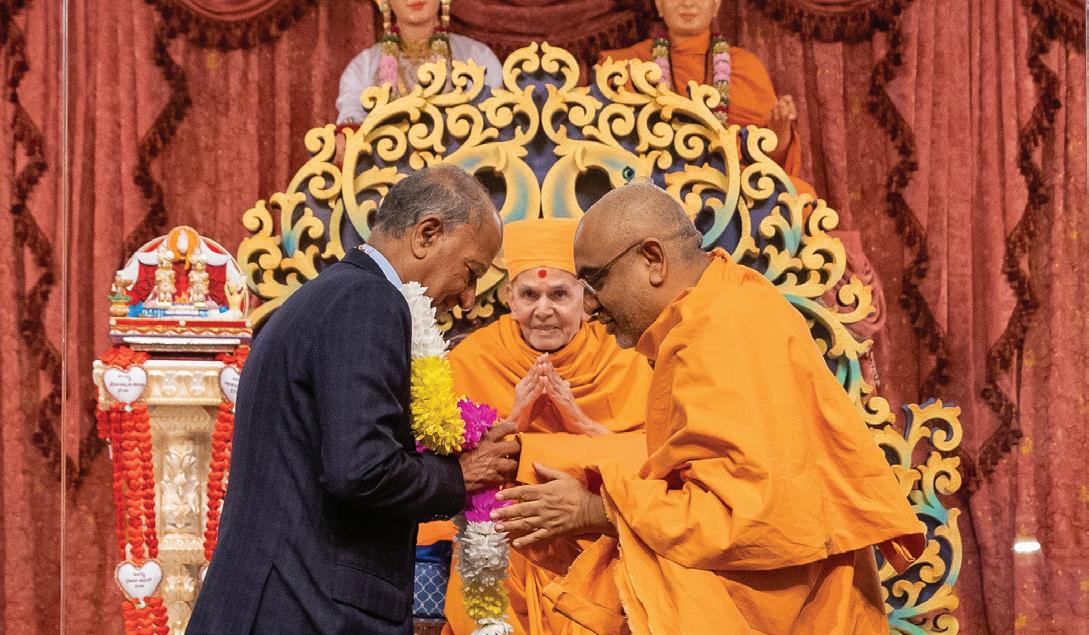


 CB interacting with PM Modi at Wembley Stadium in 2015 when he made the announcement of resuming the direct flight London-Ahmedabad-London
On 20th August 2003 Gujarat Chief Minister Narendrabhai Modi inaugurates Shakti Hall in Karma Yoga House, office of Gujarat Samachar and Asian Voice.
CB interacting with PM Modi at Wembley Stadium in 2015 when he made the announcement of resuming the direct flight London-Ahmedabad-London
On 20th August 2003 Gujarat Chief Minister Narendrabhai Modi inaugurates Shakti Hall in Karma Yoga House, office of Gujarat Samachar and Asian Voice.
Reminiscing the last many centuries, this is perhaps the most exciting time to be an Indian. The data collated by British economic historian Angus Maddison show India was the richest land on earth by far in the first millennium of the Common Era. By the first few centuries of the second millennium, during the rule of the Delhi Sultanate and later the Mughals, India had fallen to second place, behind China. The British Raj was, as all know, disastrous for India. By 1947, India was among the poorest countries
on earth. But, according to the analysis of scholar Ruchir Sharma (formerly of Morgan Stanley), India’s relative economic decline continued post-independence, because of our socialist policies. Our rise, from the economic bottom, began only in 1991. Since then, India has turbo-charged ahead, and is now the fifth largest economy in the world, even ahead of its former colonial master, the UK.
As India rises economically, it will get reconnected to its ancient roots, and give up vestiges of Western imperialism and colonial thought process, including socialism. On the surface, this will reflect in the deep interest in our foundational epics,
Amish Tripathi is the fastest-selling author in Indian publishing history, having written the Shiva Trilogy & Ram Chandra Series. He is also a diplomat, working as the Minister (Culture & Education) at the High Commission of India to the UK and Director of the Nehru Centre, London.
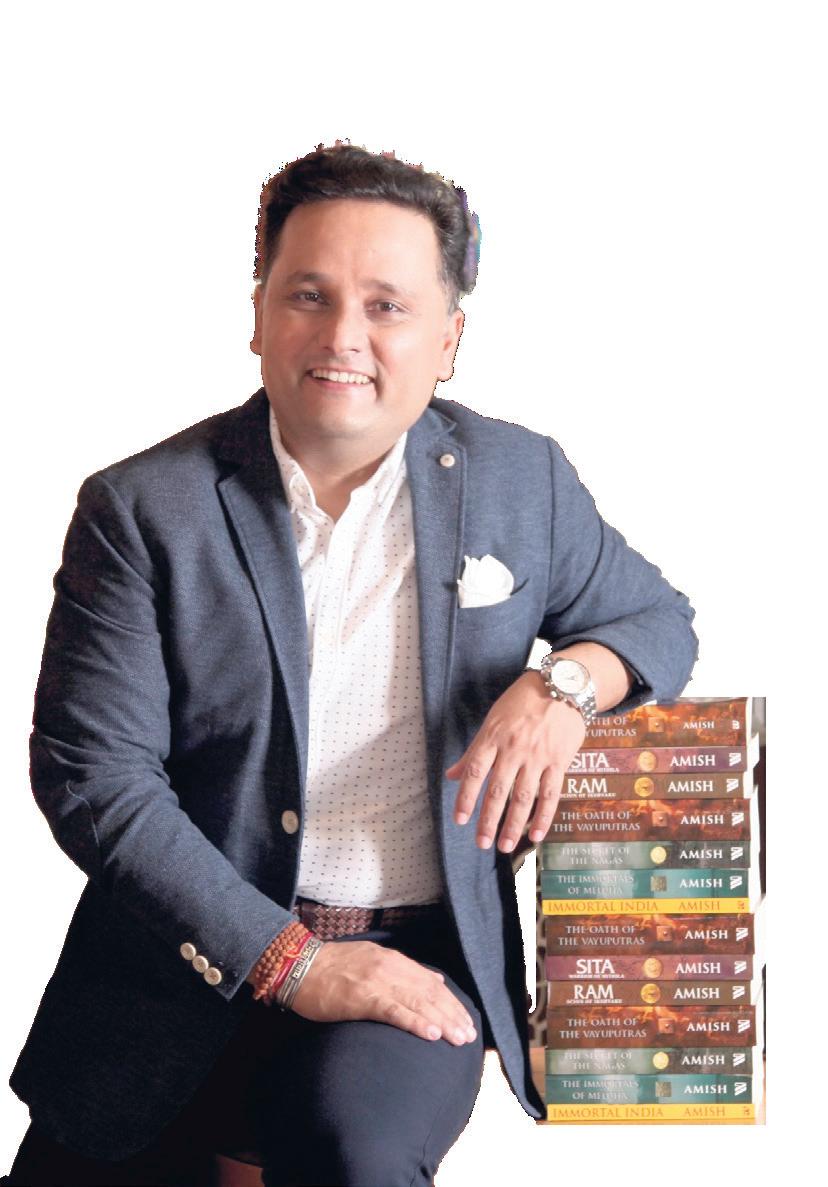
the Ramayan and the Mahabharat. It shows in the dramatic interest in TV serials based on these stories. Interestingly, the repeat telecast of the 1980s TV series on the Ramayan, during the Covid pandemic, drew higher viewership in India, than the Game of Thrones did worldwide! In a smaller measure, the success of my books of the Ram Chandra Series is also another example of this.
The hope, however, is that we will delve deeper. We should explore all our ancient texts, including the Vedas and Upanishads, and not just the epics. But even when we explore the epics such as the Ramayan and the Mahabharat, can we go deeper than the story? Can we explore the philosophies hidden in these great texts as well?
It is indeed interesting that in all the versions that we have of the Ramayan, very little of the text is devoted to what Lord Ram is most famous for, namely, Ram Rajya or the Rule of Ram. The story usually centres around the struggles of Lord Ram, usually up to the time when he returns with Goddess Sita after defeating Raavan and rescuing her. Some of the philosophies that Lord Ram seemed to subscribe to (and would therefore implement in his rule), are discussed in texts such as the Yoga Vashishtha, although in the main text of the Ramayana,
it is largely his story up to the time he returns and becomes king, and perhaps a quick summary of events thereafter in the Uttara Kand. Ram Rajya is not discussed in too much detail. Even the word Ramayana, literally means the Journey of Ram. But in the hearts and minds of practically all Indians to this day, the term Ram Rajya evokes powerful memories; like a talisman for our souls. It is the basis of our love and respect for Lord Ram. If you ask Indians in India - and indeed Indians across the world - what is the best way to administer a kingdom, regardless of religion, caste or linguistic background of any Indian being asked, practically all would say, Ram Rajya.
There can be various theories on why the term Ram Rajya is so viscerally felt among most Indians, many millennia after Lord Ram, but yet, there is little discussion of it in Ramayana. Perhaps governance discussions are boring, but battles and love-stories are made for epic tales! Few readers of the Mahabharat would list the governance lessons in Shanti Parva as among their favourite sections. Or maybe Indians of that era already knew of the contours of Ram Rajya and were interested in only listening to the journey of the great God who actually set it up. Actually, another possible explanation appeals to me. May be each era has its own
Ram Rajya. The Indians who lived in Lord Ram’s time experienced their own concept of Ram Rajya and our ancestors decided that their descendants must make up their own minds on what Ram Rajya should be. Therefore, our tradition dictates that we must all think, ponder and debate, collectively, on what Ram Rajya can mean in today’s times.
Rāmarājyavāsī tvam, procchrayasva te śiram
Nyāyārthaṁ yudhyasva, sarveṣu samaṁ cara
Paripālaya durbalam, viddhi dharmaṁ varam Procchrayasva te śiram, Rāmarājyavāsī tvam.
Viewed from this perspective, the various versions of Ramayana are an inspiration for what we can be; how a leader should or should not be. Equally important is how a people should or should not be. Most importantly, what is the central thrust of what we, collectively, as a society, hope to achieve. What kind of society
do we want?
What are the Texts we should refer to? What is the Indian dream? What is our approach to science? What is our approach to Women’s rights?
rights (as the Indian anglicised elite did) or do we believe in One law for all, built on the foundation of individual rights and equality? What is the balance between economic growth and environment? What is the balance between pacifism and resisting countries who do not wish us well? What is the balance between order & freedom? Do we believe in the concept of guilt for historical crimes? Do we believe in the concept of community guilt? What is our approach to education? To history? To the arts? To literature?
You live in Ram’s kingdom, hold your head high.
Fight for justice. Treat all as equal. Protect the weak. Know that dharma is above all.
Hold your head high,
You live in the kingdom of Ram.
What is our approach to sexual and religious minorities? Do we believe in multiple laws based on group
There is so much to be discussed. So much to be debated. That is my hope for what we can learn from the Ramayan, its commentaries, and the philosophical texts associated with it. Perhaps those debates can happen in the to-beconstructed Ram Janmabhoomi temple, in a spirit of investigation, mutual respect, and maturity. But more importantly, the debates should
not be just talk. They must convert into karma. We must put those thoughts into action; action that will work for the good of the common people. Perhaps, sometimes, with disagreement, but preferably without being disagreeable. For that is what Lord Ram would expect us to do. For that is the finest way to honour Him.

These days we seldom hear of companies that have survived for five decades and are still going strong and serving the needs of its customers. The ABPL group which produces Gujarat Samachar and Asian Voice has come through a glorious 50 years and still remains very much at the top of its game, covering news and events and remains the one of foremost publication in English for the young and old British Asians in the UK.
Having been around for five decades the newspapers would have witnessed several ups and downs of small family-run business trying to grow, now covering topics that may have related to the initial hardships faced by an immigrant population struggling to find its feet, to the huge successes that Asians have since achieved in the UK, from business, to commerce, from professionals trying hard to make their presence felt to great success within all professional fields today.
Cyrus Todiwala OBE DL is a chef, restaurateur, educationist, author and entrepreneur. He runs four restaurants namely Café Spice Namaste at the edge of the City of London, Mr Todiwala’s Kitchen at the deluxe Hilton London Heathrow Airport Terminal 5, Mr Todiwala’s Kitchen at the Lincoln Plaza London, part of the Hilton Curio Collection and Mr Todiwala’s Petiscos in Buckhurst Hill.
Looking at our own migration to the UK in the 1990s, one must say that the face of British hospitality has changed tremendously. Today the Asian community is well entrenched in businesses across the UK and abroad within our industry and yet little is known of their success. The food scene has certainly evolved much to the joy of people like me who first tried very hard to convince their customer-base that there is more to fine Asian dining than meets the eye in Britain. The change has happened. People can now relax and introduce their customer-base to a wide plethora of Asian flavours and cuisines, without the fear of rejection.
The evolution of food and cuisine needs to reach the discerning and the hungry-for-knowledge and it is true that publications do their bit in ensuring that trends and styles are well conveyed to their readership, encouraging them to embrace what is happening around them and to be proud that today we can boast and say, “Asian Food is Britain’s Number one Food.” I could not have said that 20 years ago for fear that we had not, at that stage, convinced the British public to be bold and demanding of better flavours and more well balanced and nutritious meals. That stigma which I witnessed years ago now seems to have eroded away gradually. To this end, the
publications that source information and research have done a fabulous job in spreading the good word and encouraging the growth of dining out that we see today.
This is exactly why papers like Asian Voice and Gujarat Samachar continue to meet the demands of the evolution taking place right in front of our eyes daily if not periodically and continue to excite its readership be it in print or online. With so much to look forward to and so much more to bring to the readership, I can only see the growth go one way.
With that I congratulate ABPL group for this wonderful achievement and the very best for the next 50 years.

Gujarat Samachar turns 50. This is a moment to celebrate its patient contribution to the vital work of cultural leadership – shifting our dominant culture towards an appreciation of diversity, relationship and interconnection vital for the ‘one planet living’ that must frame our future.
The consciousness of living in a global age, of rapid change, radical inter-connection and pervasive complexity, is unsettling. These are powerful and uncertain times. The experience can be overwhelming, exceeding our capacity for effective action,
inviting resignation or even despair. As Tenzin Rigzin told our International Futures Forum (IFF) learning journey to the Vidya Ashram in Varanasi nearly twenty years ago:
“We are all trying to find our roots in this storm”.
In this moment, culture matters. We have to try to make sense of today’s confusion and instability at a cultural level. We are a culturally created and culture creating species. Whenever external circumstances undergo radical and confounding change, it is felt at a cultural level as well as in the lives of individuals.
Our culture will typically tell us what it is to be ‘successful’, how to express our values in context, how
to encounter people different from ourselves. It will shape our identity, whether we choose to conform or rebel. As we grow into culturally expected ways of being and acting by participating in family life, governance, education, economics and art we reproduce the conditions that will “cultivate” the next generation.
But what happens when those cultural patterns are in a flux? When the old rules no longer function well because they are not up to the new levels of complexity, uncertainty and rapid change in society, but new rules have not been written? When we no longer know how to behave? When separate stable cultures are inevitably brought together by the forces of globalisation and interconnection, migration and displacement? How then are we to learn to live together?
The IFF has found that the first step is awareness. We need to acknowledge this unsettling reality and the unconscious psychological responses it provokes.
There is a default defence of denial and withdrawal as protection against change and anxiety: reinforcing fundamentals, sticking to ‘the old ways’, building barriers, striving to keep the complexity of modern life at bay.
That response works against the grain of a changing world and requires energy to sustain. Eventually it will be overwhelmed. The collapse can come suddenly, like an avalanche, or as a slow slide into decay. This is a dangerous, psychotic level of defence against unbearable levels of anxiety.
There is another way. We can work together to fashion a new culture that will support us to live well in powerful times, neither tuning out reality nor getting lost in it. We can engage with reality, sit in the messiness for a while, grow through this challenge to reassess the ways in which we think, act and live together. This is what humans do. We saw it in the many positive and potentially transformative responses to the pandemic, memorably described by Arundhati Roy as an opportunity “to rethink the doomsday machine”, opening a “portal” to a better world.
This capacity shows up often as cultural competence, a flair for working across cultures. This is becoming increasingly important in a global, interconnected and highly mobile world. Some have dubbed it ‘allophilia’ – the love of the other, a position that goes well beyond ‘tolerance’ to a positive relishing of multiple cultures and perspectives.
The novelist Zadie Smith commented
on President Obama’s capacity to ‘speak in tongues’ – a phenomenon she observed on the campaign trail in 2008 as he subtly, and unconsciously, shifted his tone of voice and his delivery to suit the inflections of the crowd he was with. In a previous era, this would likely have been seen as a mark of slipperiness and inauthenticity. But Obama, like Smith herself, is a hybrid person, a product of several cultures. It gives him a fluency that is nonetheless authentic, and entirely at home in today’s fluid times.
We can all develop this cultural literacy – recognising the cultures in play, how we participate in them, how we can change them, the fact that every intervention is a cultural intervention, implicitly carrying a culture with it.
This competence can be seen behind the work of many of the visionary actors in our society, cultivating hopeful imagination, technical expertise and broad life experience to create the new spaces and patterns of life we desperately need for a viable future for our common humanity and for the planet.
building and investing in civic infrastructure for neighbourhoods of the future. Or organisations like Healing Justice London and MAIA group working explicitly on culturemaking, growing the capacity for imagining, community repair and healing that makes all the work of world building possible.
Culture matters. Working effectively across and within many cultures is a core 21st century competence. Asian Voice’s contribution to cultivating this capacity is something to celebrate. Long may it continue.
I am thinking of initiatives like Civic Square, a Neighbourhood Economics Lab in Birmingham visioning,
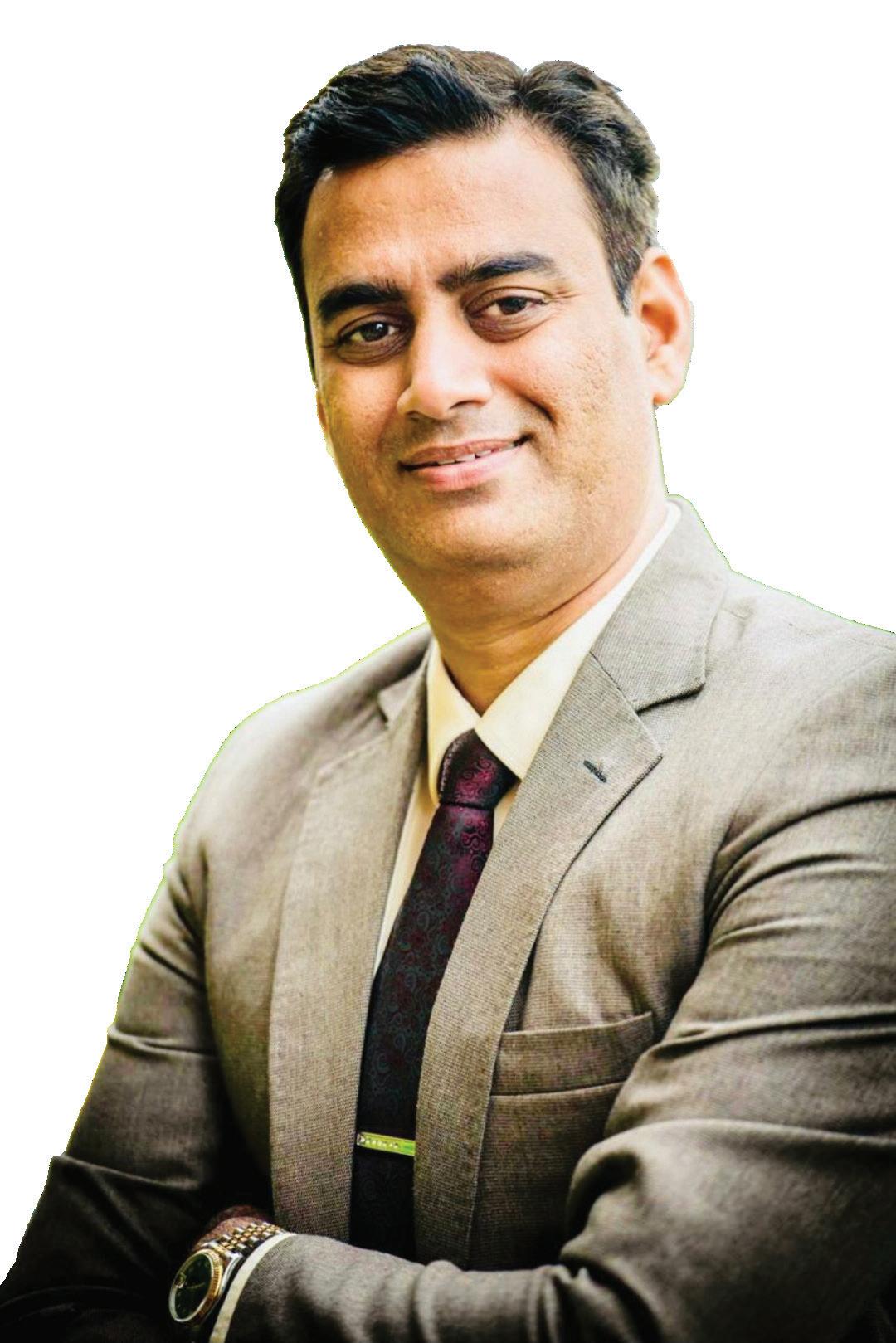
The world is in transition. Everything is changing. And they are changing so quickly that while we try to absorb and mitigate what has already happened, a new change faces us. The transformation from the Machines Age to the Internet Age and now the forthcoming Artificial Intelligence Age shows that the pace of change is rapid. We don’t know what is in store in the near future that will affect every aspect of our lives.
As a diplomat, if I cast my sight on the horizon 25 years from now, I can see both - change and continuity.
Diplomacy has been part of life, society, and international relations since the origin of society. We all are diplomats in our daily lives. Diplomatic skills are used in family and business. Yet, when it comes to international relations, this field requires very specialized knowledge, skill, and attitude. Used properly, diplomacy can save millions of lives, and vice versa. This importance of diplomacy will continue to increase in the future.
Rohit Vadhwana, Deputy High Commissioner of India to Nairobi & Deputy Permanent Representative to UNEP & UN-Habitat. As a diplomat he has been posted in several countries including the UK where he served as the First Secretary (Economic & Commerce wing, Press & Information), with additional charge of Press & Information Wing at the High Commission of India in London.
Speaking in terms of international relations, diplomatic relations are already undergoing changes. Communication has become faster and more direct. Earlier there used to be diplomatic bags through which ambassadors would send reports and assessments to their headquarters. Today, most of them are sent through electronic mediums, even though diplomatic bags still exist for very specific purposes. Many meetings are conducted online, in virtual modes. This is a drastic change we have seen since covid-19, wherein most of the meetings and conferences are in hybrid mode. People have the choice to travel to the venue or join from their place. It has influenced diplomacy also. Imagine a meeting being conducted from Delhi at midday and it would be joined by India’s diplomats sitting across the world, in different time zones. It is no more a business of Embassy hours. This change will become increasingly permanent. Diplomacy will be conducted long distance. The presence of ministers in big conferences could be seen through their hologram 25 years from now.
Another essential part of diplomacy is meeting people, networking, and making connections. It used to be much less frequent except during diplomatic parties, national days, or visits of high-level dignitaries. Sometimes, it would be on special
invitations. There were many events where diplomats were not required to be present, but today, they are working more like corporate executives than government representatives. Their task is not only limited to political insights and assessments but also keeping an eye on the commercial and technological developments in the country of their posting. Trade and commerce have taken up a large part of diplomatic work today. And in the next 25 years, it will further dominate the space. Economic might will certainly define the power of a state. Therefore, economic diplomacy will play a more important role 25 years from now.
Defense and military ties are always part of diplomatic work since ancient times. In fact, it is said that diplomacy is a means to avoid war. When diplomacy fails, war begins. British politician Tony Benn said, “All war represents a failure of diplomacy.” There was a time when there was a sense of confidence that two nations with nuclear power would never go to war, but it has proven to be a fragile argument, although nuclear deterrent has worked to a certain extent. However, in the future, we cannot rule out the dominance of military powers, but it will have to make space for economic might. Raw strength in the defense sector might prove futile. Hence, with time, power will need to be exercised more in
terms of technological and economic might.
For countries like India, which has a strong diaspora abroad, the time frame of 25 years in the future, could mean the role of the diaspora would be more important. Today, the Indian diaspora occupies important positions globally, in politics, international institutions, and the corporate world. The future holds a much stronger connection between diplomacy and diaspora. No wonder India has divisions in the Ministry of External Affairs that focus on connecting with the diaspora abroad. Our diplomacy has already seen changes in its diaspora interaction, starting from long-term visas to PIO cards, and then OCI cards. It has increased the access and assimilation of the diaspora in Indian society and the economy. In 25 years, there will be even closer integration on this front.
It is not easy to predict changes in the next two and half decades, but I am making this conservative assumption as a hopeful.
(Expressed opinions are personal.)
 CB interacting with Morari Bapu during his recent Ram Katha at the Jesus College, Cambridge University
CB interacting with Morari Bapu during his recent Ram Katha at the Jesus College, Cambridge University
Universal education systems have been the well-spring of the mass flourishing of individuals, nation states and the global economy over the past couple of centuries. But the forces driving our economies and societies in the 21st century are very different from that in the 19th and 20th centuries and so too will be the demands placed on our education systems if we are to collectively thrive. From a long list, let me select three of those secular driving forces. As in earlier centuries, all three could be seen as posing a near-term
educational challenge, but also in opening up a significant mediumterm opportunity to unlock the potential in people.
The challenge technology poses to people, their jobs and skills is now relatively understood. The Fourth Industrial Revolution will most likely lead to a massive skills transition in the decades ahead, one at least as large as the industrial revolutions of the 18th, 19th and 20th centuries. Most outside studies point towards between half and three-quarters of all jobs undergoing some significant change over the next few decades.
Andrew Haldane is the Chief Executive of the Royal Society of Arts (RSA). He was formerly Chief Economist at the Bank of England and a member of the Bank’s Monetary Policy Committee. Among other positions, he is Honorary Professor at the Universities of Nottingham, Manchester and Exeter, Visiting

Similarly, there will be significant changes in the skills needed for the future world of work, if we are to escape the clutches of the machine and AI displacement, with importance being placed, in particular, on vocational and interpersonal skills - the skills that cannot be as easily replicated by robots. There are, however, also vast opportunities new technologies present educationally, specifically, in digital and AI technologies. Thus far in human history, the main constraints on learning have been hard constraints – numbers of teachers and schools.
Technology has and will continue to loosen these constraints. For example, AI means that completely personalised learning, fine-tuned to our individual learning styles, is now well within our technological grasp. This could potentially be transformative for how we teach and learn, unlocking the potential of many more people.
We are living in a world where people born today will plausibly live 100-year lives and have 70 or 80year careers. In the future, many people will need to undergo multiple transitions, not just in jobs but in careers. This will put a much greater premium than ever before on making lifelong learning a practical reality. Doing so would greatly enhance potential economic and societal gains. It would expand the workforce with experienced and expert people, their skills renewed and refreshed, while also boosting the wealth and wellbeing of these individuals.
Educational differences are seeded in early years and grow through people’s lifespan. These educational inequalities in turn create inequalities in opportunity, income and wellbeing through the life course. Many people leave education loathing learning. This means those, often most in need of lifelong learning, are least likely to engage in such learning, amplifying educational inequalities. Some of this inequality arises from Professor at King’s College, London, a Visiting Fellow at Nuffield College, Oxford and a Fellow of the Royal Society and the Academy of Social Sciences. Andrew is Founder and President of the charity Pro Bono Economics, Vice-Chair of the charity National Numeracy and Chair of the National Numeracy Leadership Council. Andrew was the Permanent Secretary for Levelling Up at the Cabinet Office from September 2021 to March 2022 and chairs the Government’s Levelling Up Advisory Council.
the model of learning used in most schools – the “chalk and talk” model assessed through examination. Many talented people do not engage well with this style of teaching, leaving their potential unfulfilled. The future education system thus needs to embrace personalised learning, education that complements individual learning styles to unlock the potential in people lost to education and lifelong learning. It is only then that we can close the high and rising inequalities in educational opportunity and outcome, as well as in incomes and wellbeing.
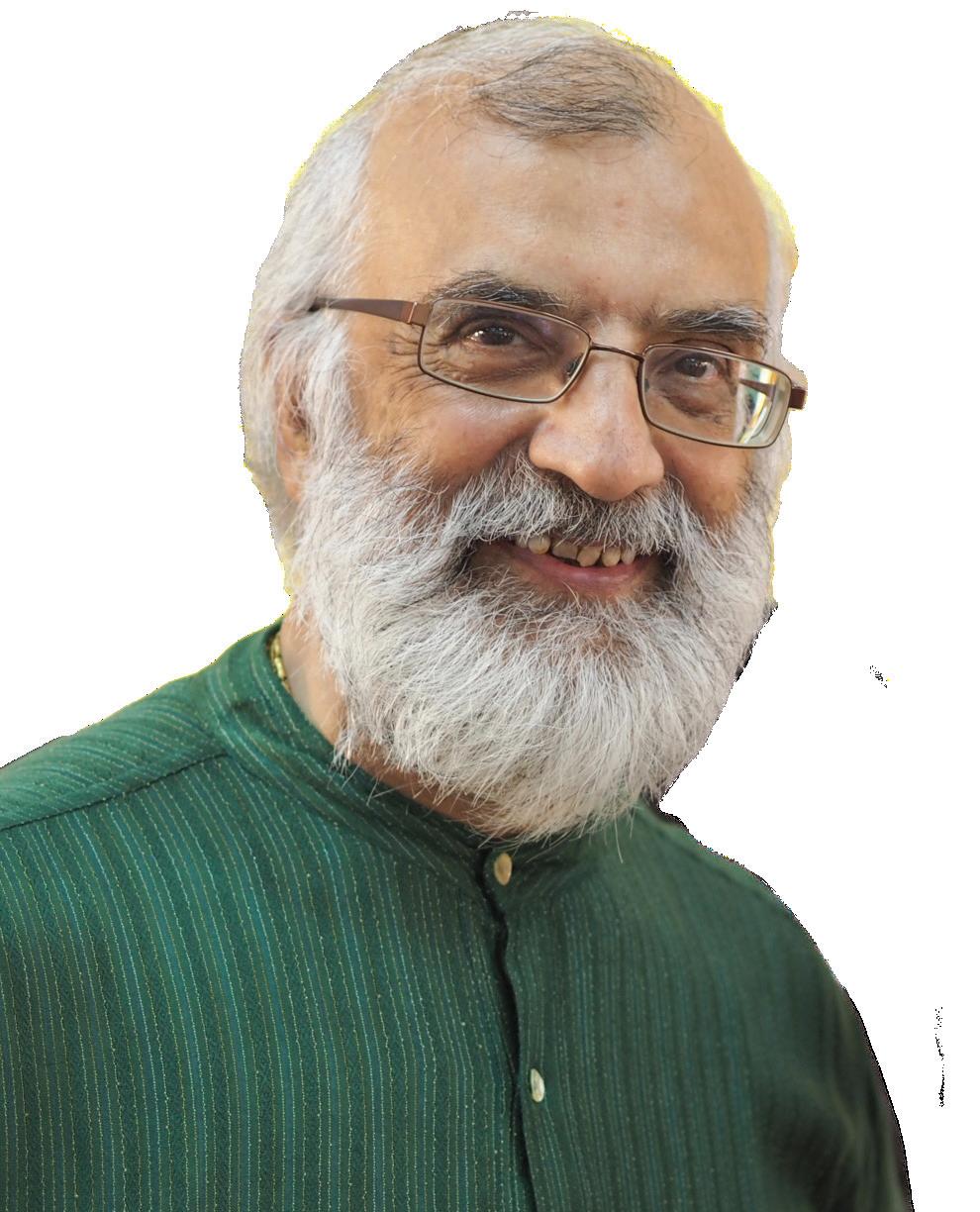
At the RSA, we are developing practical interventions as part of our Design for Life programme that allow us to future-proof the education system, avoiding the pitfalls and maximising the opportunities presented by inequality, technology and demography.
At its heart, the Design for Life programme is about enabling people, places and the planet to flourish in harmony. It is a regenerative, systems-shifting and systemsshaping mission, one that applies with particular force when it comes to regenerating people, their learning and our educational systems. For example, we are developing a nextgeneration capabilities framework
that better matches what will be needed to make a success of this century, highlighting the importance of transferable capabilities and attributes from creativity to citizenship to empathy. We are building a sequenced pathways of learning in the form of a Design for Life Awards scheme to nurture and grow, recognise and reward those often-invisible skills needed for the lives and livelihoods of the future.
To complement the successful first phase of our Cities of Learning programme, we are building a “whole place” skills eco-system across a number of UK cities, connecting often fragmented skills systems, convening often disparate skills providers, reaching often hard-toreach learners, and rewarding oftenunrecognised skills and attributes through digital badging.
It is only with a robust commitment to re-designing our education systems, and practical interventions like the ones spotlighted above, that will lead us to successfully unlock the potential in people, economies and societies in the 21st century.

Whenever I met up with Mr C B Patel, I was amazed at his enthusiasm for all things related to the community. He knows about my deep interest not only in psychology but also Hinduism and in particular, meditation. He always wanted to know more about these areas of knowledge. In turn I would be fascinated by his commitment to his professional life in the media and his determination to serve the community in all different ways. What came to mind, when I was reflecting on the style of his leadership, was the idea of the servant leadership, which
many scholars and practitioners have found deeply rooted in out Hindu philosophy and practice. The concept of servant leadership is found in many Hindu scriptures, particularly in the Bhagavad Gita.
Lord Krishna, the Divine teacher in the text, emphasises the importance of selfless service and placing the needs of others before one’s own. This type of leadership is known as “seva” in Sanskrit and is considered a fundamental aspect of Hindu spirituality. The Bhagavad Gita also teaches that a true leader is one who inspires and empowers others, rather than using their power for personal gain. This concept of servant leadership is still widely recognized and practiced in India today.
The model of servant leadership in psychology is an approach to leadership that prioritises serving the needs of others and empowering them to reach their full potential. It is based on the idea that leaders should view their role as one of service to their followers, rather than using their power to control or dominate them.
This model of leadership emphasises that a servant leader should have a deep commitment to the growth and development of others, as well as a strong sense of their own ethics and values. They should also be empathetic, self-aware, and skilled at building relationships.
Research has shown that the servant leadership model can be effective in improving employee satisfaction, engagement, and performance, as well as promoting organisational citizenship behaviours and creating a positive organisational culture. It has also been linked to higher levels of follower trust, loyalty, and commitment to the leader and the organisation.
psychologists include:
Service: The servant leader prioritises the needs of others and works to serve them rather than seeking personal gain.
Empathy: Having the ability to understand and share the feelings of others and being able to put themselves in their followers’ shoes.
Healing: Working to promote the well-being and personal growth of their followers and helping them to address their individual needs.
Awareness: Being self-aware and able to recognise their own strengths and weaknesses, as well as the needs of their followers.
Persuasion: Using persuasion rather than coercion or positional authority to influence their followers and promote positive change.
Conceptualisation: Having the ability to think beyond day-to-day tasks and seeing the bigger picture, developing a long-term vision for the organisation.
Foresight: Being able to anticipate and planning for the future and taking a proactive approach to problem-solving.
The dimensions of servant leadership, as stated in the Hindu scriptures and researched by
Stewardship: Taking responsibility for the well-being of the organisation and its followers and working to ensure that resources are used in an ethical, responsible and sustainable way.
Commitment to the growth of people: Being committed to the personal
and professional growth of their followers, providing opportunities for development and empowering them to reach their full potential. Building community: The servant leader fosters a sense of community and collaboration within the organization, promoting teamwork and cooperation among followers.
Bhagavad Gita is the sacred Hindu scripture that teaches the concept of service, known as “seva” in Sanskrit. The text emphasises the importance of selfless service and placing the needs of others before one’s own.
Lord Krishna, the Divine Teacher in the text, encourages his human disciple Arjuna, to act in the service of others, emphasizing that service is a form of devotion.
Bhagavad Gita teaches that service should be performed without the expectation of reward or recognition, as it is an act of devotion and a way of connecting with the divine through transactions with the world. The text also emphasises the importance of performing one’s duties in a spirit of service, whether in personal or professional life. This is known as “karma yoga,” or the yoga of action, which involves performing actions with devotion and without expectation of reward.
Through the practice of seva and karma yoga, Bhagavad Gita teaches that individuals can purify their minds and hearts, cultivate humility, and develop a deeper sense of connection with others and with the divine. It also emphasises the importance of using one’s talents and abilities in the service of others, as a way of contributing to the greater good and promoting the welfare of all beings. Mr C B Patel is certainly one of these formidable personalities, a servant leader who has visibly contributed so much over the last 50 years.
For the millions of Chinmaya Mission members and many more from all backgrounds throughout the world, our beloved Pujya Gurudev Swami Chinmayanandji was indeed the epitome of the servant leader. He worked selflessly in the service of humanity until His last breath, lifting a diversity of individuals into joyous, selfless contributors in society.
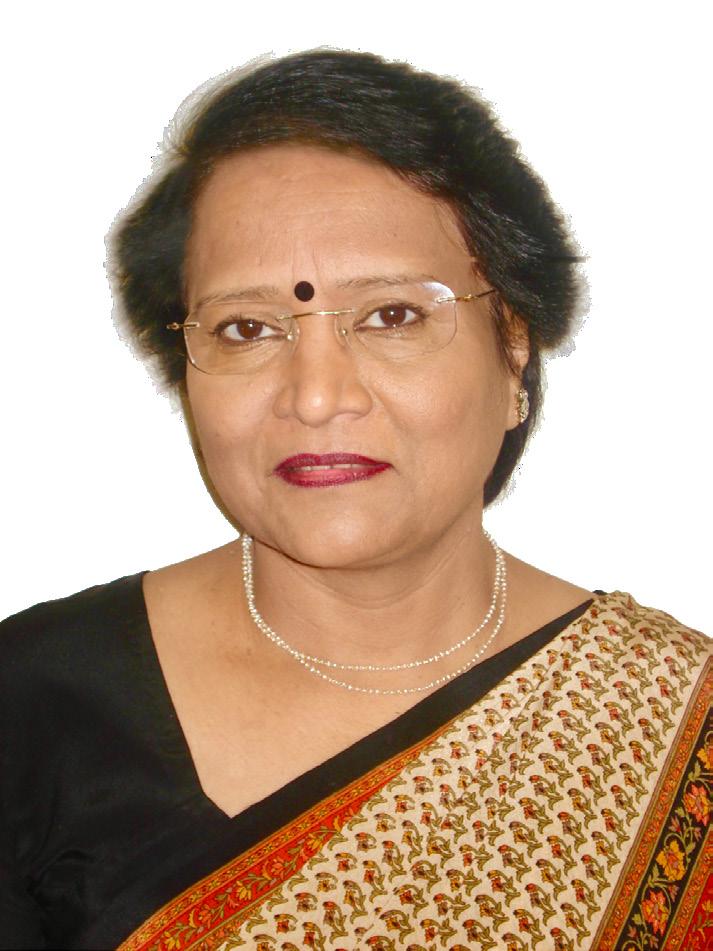
The Gujarat Samachar and Asian Voice represent Gujarat and Gujaratis in England, along with a wide readership around the world, including Europe. The golden anniversary of Gujarat Samachar is being celebrated, it is natural that we want to know about its struggles and successful journey. Since 1983, taking responsibility as the Managing Director from being the typesetter, my association with Gujarat Samachar has lasted for almost four decades (40 years). I have seen the entire journey of how Gujarat Samachar has arrived to such a height
of success. At such a moment, I feel a sense of pride in presenting the development process of both Gujarat Samachar and Asian Voice.
On the occasion of today’s golden anniversary celebration, it is important to know how Mr CB Patel became the publisher and Editorin-Chief, and how he navigated through various circumstances and challenges.
With a belief that “After my preferred deity, Lord Shiva, I believe that my readers are my God,” CB has been showered with immense love, respect, admiration, and cooperation from his readers. CB
Born in Vasad (Gujarat), Kokila Patel completed her Bachelor of Arts (BA) with Honours at Sardar Patel University in Vidyanagar (Gujarat). She came to Anand, and following her marriage to Dr. Pravin Patel, a renowned eye surgeon, she permanently settled in the United Kingdom in 1977.
hasn’t just focused on financial gains in the newspaper business, but has also created a platform to address societal issues. Through impartial, fearless, and ethical journalism, the persona of CB Patel, who is not just an individualistic figure today but has become a figure for the whole society, has been moulded.
In 1960, CB went to Dar-e-Salaam from Vadodara. Starting as an accounts clerk and later working as a clerk in civil service, he simultaneously studied for his LLB and Bar-at-Law. In 1966, with a strong desire for further studies, CB Patel arrived in London, along with a firm determination to carve out his own path in the country amidst challenging circumstances. He became financially secure and ventured into the grocery store business, with the support of his family members, relentless hard work, and by facing challenges headon, he gradually began to experience the blessings of prosperity.
During academic days, he used to read many books. While living in
Dar-e-Salaam, he came in contact with Randhirbhai Thakar, who ran a Swahili newspaper, an idealistic and enthusiastic journalist-publisher. CB realised that Public Welfare Work through newspapers is a very effective medium. This realisation drew him towards the publishing field. In 1973, when CB Patel went to celebrate Diwali with his family, he met his ascetic father after 13 years. His father explained that not only is accumulating wealth important in life, but it is equally important to set aside something for public welfare. This insightful advice from his father brightened CB’s future and determined his journey in the publishing field.
On May 5, 1972, Kusumben Shah, Pranlal Sheth, Nalinikant Pandya, Balwant Kapoor, and Yudhveer came together in London to initiate ‘Gujarat Samachar’. As the team gradually dispersed, it became challenging for Kusumben to manage the responsibilities on her own. With few readers, CB took over the reins of Gujarat Samachar.
In October 1983, she joined Gujarat Samachar as a typesetter. Over the course of 40 years, she has served various roles within the editorial team, including Associate Editor, Consulting
Editor, and, for a long time, Managing Editor, and has actively contributed to knowledge and service-oriented activities. Presently, she serves as the consulting editor of Gujarat Samachar.
After some time, they shifted the newspaper’s operations to the basement of a building on Cheesik High Road in Southall. At that time, Sukhlal uncle and Soma uncle worked together to assemble the blocks and create the typeset for the newspaper. CB cherishes the dedication of these elders. Once in January, when it was snowing heavily, and Sukhlal uncle’s hand got fractured, it became difficult to publish the newspaper. Sukhlal uncle, undeterred, continued to compose with one hand, and the newspaper was eventually published on the scheduled day.
In 1980, CB purchased a building with four floors on 8-16 Coronet Street, near Old Street, London. This building, Karmyog, became the office of Gujarat Samachar. Around this time, the idea for a new English weekly newspaper called New Life was born. With the support of everyone New Life gained popularity in the local council and parliament, CB fearlessly addressed the questions and concerns of Asian-Gujaratis who had recently arrived from East Africa. He wrote articles that provided candid and impactful responses to issues faced by Asian immigrants, covering topics ranging from family, social, educational, to business matters. Through these efforts, the reader base of Gujarat Samachar and New Life became strong in the community. Especially for Gujarati
and Indian families in Britain, these periodicals became their favourite.
In 8-16 Coronet Street, the initiation of Gujarati typesetting began on a Linoterm machine. This Germanmade computerised phototypesetting machine was used for preparing matter, graphic work of newspaper was also done manually. In July 1983, Jyotsnaben Shah joined the journalists’ team, and in November, I (Kokila Patel) became a Gujarati typesetter in this publication group. CB Patel’s office accounts were transferred, and the staff was increased. Due to lack of the latest technology and the availability of basic equipment, work continued in the office until late at night. Yet no signs of fatigue or unfamiliarity were seen on anyone’s faces. It was like a united family working together.
Just like preparations for Ashtami’s Navratri, in Gujarat Samachar all the office members used to start working to give readers Diwali edition full of different content. The cover page of the Diwali special edition, adorned with creative painting by the late Ram Bhakta, was appreciated with the “Best Special Issue” award from the Mumbai Gujarati Journalists’ Association.
CB Patel used to consider the members of Gujarat Samachar and New Life as family. When it came to work, he communicated with
precision, both through words and gestures. He valued collaborative effort of the team. Every Monday, Wednesday, and Friday, he held meetings with the typesetting team to discuss news updates. This routine has been followed for years and continues to this day. They all gathered to analyse the news and keep the typesetting team informed and engaged, providing them with inspirational mantras like “Awareness through Thoughts” to stay alert.
In 1984, a grand event with an attendance of 1000 invited guests marked the rebirth of Gujarat Samachar and New Life in tabloid size format, transitioning from A4sized magazines. In 1985, on the occasion of the 14th anniversary of Gujarat Samachar, a special edition titled “Gujarati Business in Britain” authored by journalist Sheila Bhatt gained recognition. The release was inaugurated by the Liberal Democratic party leader, David Steel.
In the following year, there was modernisation of office equipment and work processes with the introduction of Lineotronic typesetting machines in place of Linotype machines. As the circulation of the weekly publications increased, more customers emerged, leading to an increase in workforce.
During this period, Iswar Vasa took
on the responsibility of managing editor, while Jyotsna ben served as assistant editor for “Gujarat Samachar”. In 1986, on the occasion of Gujarat Samachar’s anniversary, a special edition titled “Gujarati Women in Britain” was celebrated. The publication was released by the leader of the Labour Party, now Lord Dr David Owen. After Jyotsnaben Shah’s visit to India in 1987, Kokilaben Patel took on the role of Managing Editor and, with the support and collaboration of Mr Hiralal Shah and Mr Jagdish Dave, managed the operations of the editorial team. During this time, approximately 25 columns were included in 24 pages, adding diverse content.
The 5th of May marks the anniversary of Gujarat Samachar. On this occasion, special editions focusing on specific topics are published. In 1987, the special edition “Asians in Britain’s Economy”, in 1988, “Who is Who in Britain”, in 1995, a special edition on weddings, in 1997, a special edition commemorating the 25th anniversary, and “Golden Jubilee of Independence Day”, in 1999, “Discovering India”, in 2001, the 30th anniversary of “Gujarat Samachar”, in 2003, the “Wedding Special”, in 2005, “British Gujaratis: Process of Transformation”, and similar informative special editions became well-known.
In the difficult times, CB Patel faced challenges with courage and determination. With the support of his family, including his wife Pushpaben, he sold two luxurious bungalows in Ealing and bought the third floor of a four-story building in the office of Gujarat Samachar.
Even during financial difficulties, CB Patel ensured that every member of the family received their salary on the first day of each month. He always said, “I am not just responsible for my workers, but also for their families.” Eventually, difficult times passed. CB never forgot the colleagues and wellwishers who stood by him.
In 1991, Gujarat Samachar witnessed the emergence of Asian Voice along with several English pages. In 1993, Jyotsnaben Shah took on the responsibility of Managing Editor at Gujarat Samachar. The entire team significantly popularised Asian Voice among the youth.
Starting from 1995, the ABPL Group became computerised. Work began on Apple Macintosh computer systems. CB’s Cambridge graduate son Merulbhai developed a program for Gujarati fonts and all sections were also computerised.
In 1999, the new construction of the office building at 8/16 Coronet Street was initiated. The inauguration took place in the presence of Swamishri
Sachidanandji. On the sacred day of Dussehra in 2001, CB’s mother Kamalaba and leaders of all religions blessed CB with a ceremonial entry into the 12 Hoxton Market, inaugurated “Karma Yoga House”.
On the ground floor of the newly constructed “Karma Yoga House,” a “Shakti Hall” was inaugurated by the then Chief Minister of Gujarat and the present Prime Minister of India, Shri Narendra Modi.
The world saw a revolution in the field of technology, and the advent of email and internet led to the creation of a “Global Village” in true sense. The ABPL Group also joined the wave of change and in 2001, they collaborated with India’s leading news agency, IANS, to provide readers with comprehensive news and reports. In 2004, they entered into an agreement with the ‘Samabhav’ group based in Ahmedabad.
Driven by the aim of satisfying the readers’ interests and demands, the Board of Directors of the ABPL Group took a decision to establish their own office in India, reflecting their commitment to greater contentment among their readers.
In February 16, 2006, with the support of senior journalist and CB’s old friend Bhupatbhai Parekh and his cancer specialist son Bhaveshbhai, the office was inaugurated at the
Shalibhadra Complex (Nehru Nagar Circle, Ambawadi) in Ahmedabad, Gujarat. The teams of London and Ahmedabad offices are working with enthusiasm in collaboration with each other.
I am greatly honoured to have received guidance and inspiration from my respected CB Sir. Following his guidance, I have also served Gujarat Samachar devotedly – a knowledge offering, and have been
providing diverse reading materials to readers for 40 years. I take immense pride in this. Moreover, it fills me with joy to have received love and respect not only from society but also from readers. It has been an incredibly gratifying experience to collaborate and cooperate with everyone until now. I extend my heartfelt wishes for the continued success of Gujarat Samachar and Asian Voice.
- Hardik Shah, Accountant ABPL Group
CB Patel and his family have contributed their time and resources to numerous human service projects through Karma Yoga Foundation and through their personal / business accounts. The total is just over £500,000. His father’s wisdom and guidance have played a pivotal role in shaping the family’s Seva journey, emphasising the importance of giving back to the community and fostering a spirit of compassion and service.
Over and above these financial contributions, Gujarat Samachar, New Life and Asian Voice have supported various spiritual, community and cultural events, especially 4 Ram Kathas, HKTDM , Preston fund raising helping to promote and celebrate the rich heritage and traditions of the Indian Diaspora in the UK through complimentary publicity.
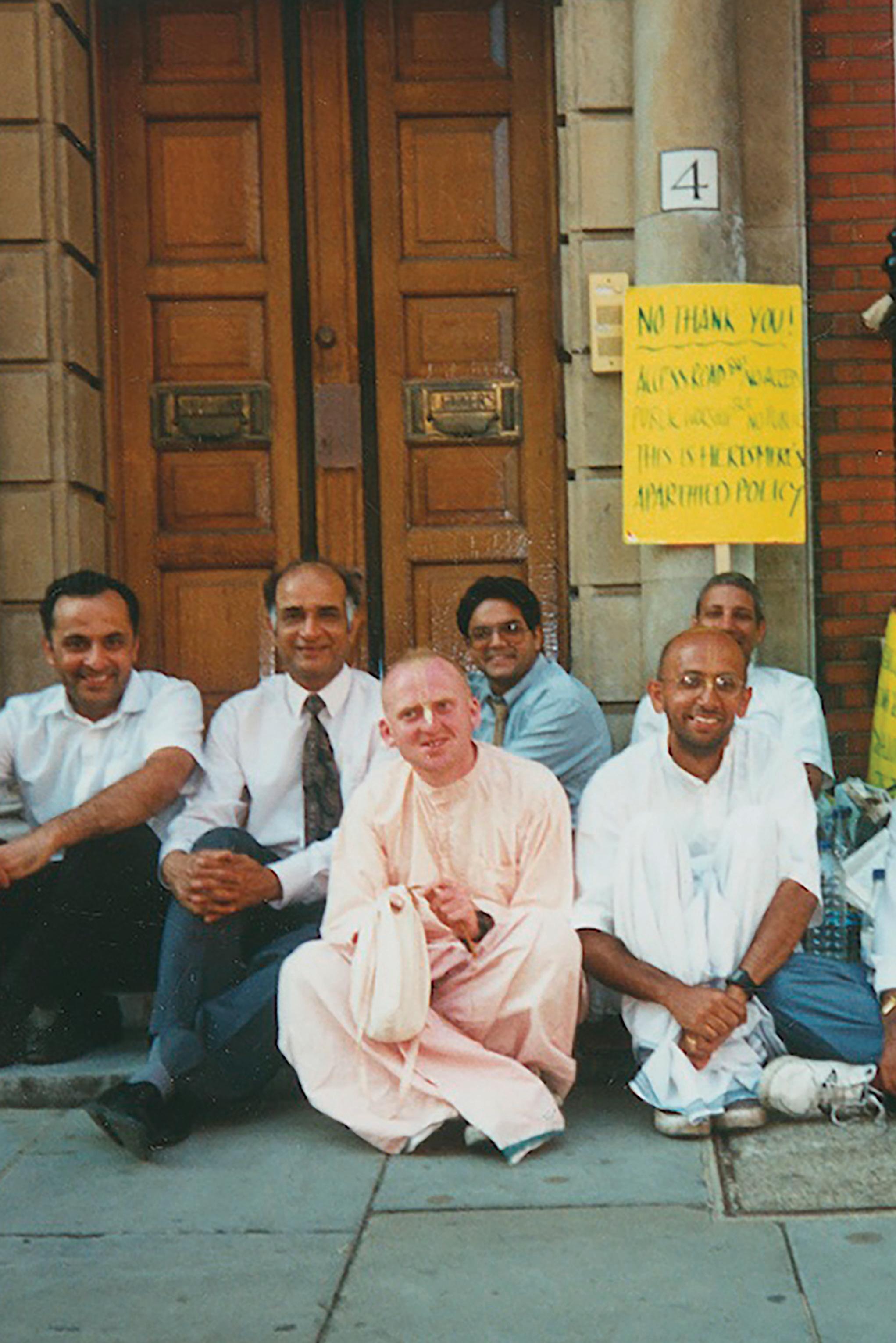







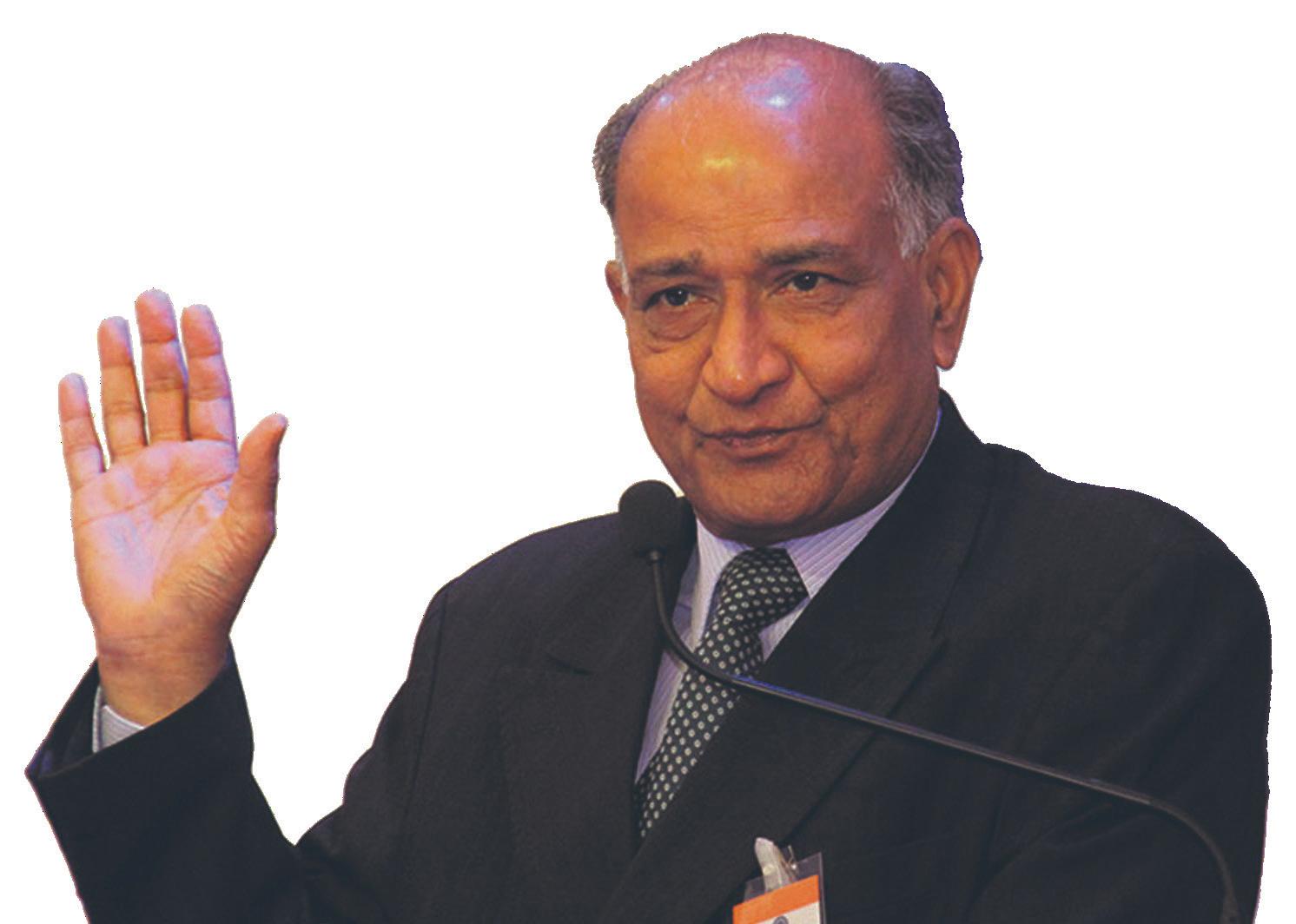










Family of Late Manubhai Madhvani
Dhamecha Group
Nagrecha Brothers Ltd
Vinodrai Bachubhai Nagrecha
Hasmukhlal Bachubhai Nagrecha
Shri Vinodkant D Vadera & Family
Kansagara Family
Lord Dolar Popat
Kaushik and Deepika Desai
Chown Dewhurst LLP
Subhash & Rekha Thakrar
Market Financial Solution
Mr Paresh Raja & Family
Interpolitan Money PLC


Mr Rishi Patel & Family
Westcombe Foundation
G u j a r a t S a m a c h a r

Uniting our community, culture and values to empower the future

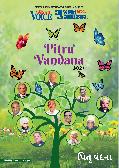
Gujarat Samachar is one of the most popular newsweeklies amongst the British Gujaratis with the highest circulation among Indian language newspapers published in overseas countries. A fiery publication spanning a journey of five decades, the publication is a loud voice for the problems and achievements of the Indian community.



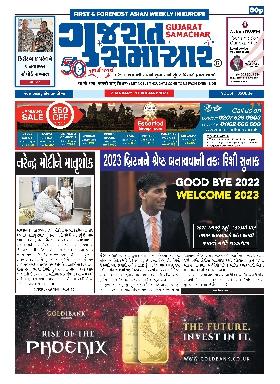
A s i a n V o i c e
Your Premier Source for South Asian News
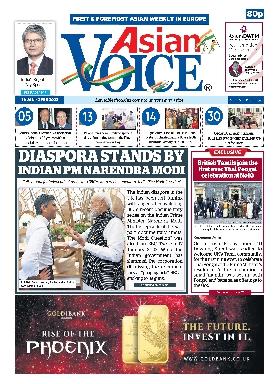
Asian Voice curates a weekly dose of current events, culture, and stories that matter to our vibrant community. At Asian Voice, we understand the importance of staying informed about local and global developments that directly impact our lives. Our dedicated team of experienced journalists works tirelessly to bring you in-depth coverage of politics, economics, technology, and social issues affecting South Asians worldwide.
Together discover the rich tapestry of South Asian culture through our engaging features, spotlighting traditions, festivals, cuisine, and inspiring individuals making a difference in our community. We take immense pride in celebrating our shared heritage while respecting the unique identities that define us.

